AMD Dishes on Ryzen Mobile 'Renoir' 4000 Series: New Ryzen 9 4900H, HS-Series Chips
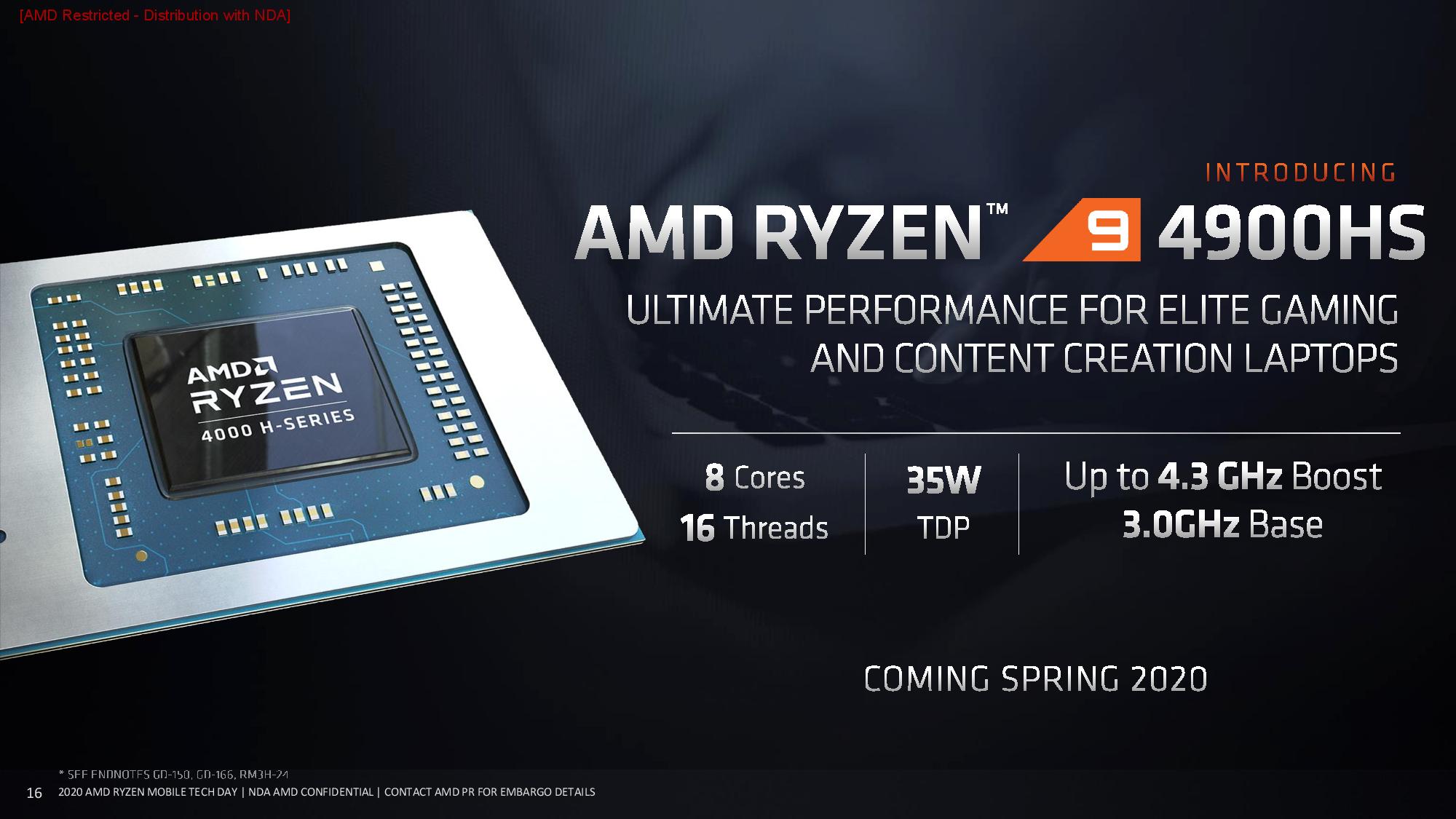
AMD teased us with the broad strokes of its Ryzen 4000 'Renoir' APU family for the mobility market at CES 2020, but shared more details at its Ryzen Mobile Tech Day on the processors that bring the Zen 2 architecture and 7nm process to the mobility market for the first time. That includes the a new flagship 45W H-series processor along with a series of downclocked 35W HS models that the company designed primarily for high-end laptops with discrete graphics cards.
These chips represent the first 7nm x86 processors for the mobile market, with the 7nm node bringing along power and performance advantages that AMD says rivals Intel's 10nm Ice Lake and 14nm Comet Lake chips. Due to Intel's continuing struggles with fully transitioning to the 10nm node, the Ice Lake chips are designed to address the gaming market with Gen11 graphics, while it positions Comet Lake processors for productivity applications due to its higher core counts. AMD takes aim at that split product family by saying that its Ryzen 4000 series processors are the no-compromise solution that address both segments with one architecture.
The company also gave us more fine-grained details on Ryzen 4000's architectural refinements to the Zen 2 architecture and Vega graphics engine, its innovative SmartShift technology, and how it achieves its battery life claims.
The laptop market comprises more than two-thirds of the overall consumer CPU market, so AMD's success in this segment is key as it continues to nibble away at Intel's desktop PC market share. AMD says its Ryzen 4000 series processors are poised to bring the company to parity, or exceed, Intel's competing chips in all of the key metrics. That includes AMD's long-held advantage in threaded workloads and graphics performance, but also now expands into challenging Intel's single-threaded prowess. AMD says it continues to make solid gains in the laptop market with a record 170 platforms on the market in 2020, of which 100 will come powered by the new Ryzen 4000 series processors. AMD also points to a doubling of its presence in the lucrative and fast-expanding gaming notebook segment. Let's see what's powering that growth.
Ryzen 4000 H- and HS-Series APUs
| CPU | Cores/Threads | Frequency (Up to) Boost / Base | Cache | Graphics Cores | Graphics Frequency | TDP |
|---|---|---|---|---|---|---|
| Ryzen 9 4900H | 8/16 | 4.4 / 3.3 GHz | 12 MB | 8 | 1750 MHz | 45W |
| Ryzen 9 4900HS | 8/16 | 4.3 / 3.0 GHz | 12 MB | 8 | 1750 MHz | 35W |
| Ryzen 7 4800H | 8/16 | 4.2 / 2.9 GHz | 12 MB | 7 | 1600 MHz | 45W |
| Ryzen 7 4800HS | 8/16 | 4.2 / 2.9 GHz | 12 MB | 7 | 1600 MHz | 35W |
| Ryzen 5 4600H | 6/12 | 4.0 / 3.0 GHz | 11 MB | 6 | 1500 MHz | 45W |
| Ryzen 5 4600HS | 6/12 | 4.0 / 3.0 GHz | 11 MB | 6 | 1500 MHz | 35W |
AMD's initial announcements covered the 15W U-series that it designed for thin and light devices that leverage the integrated Vega graphics engine, along with the 45W H-Series that comes with Vega but will often power laptops with discrete graphics cards for creators and gamers.
AMD splits its 45W Renoir chips into the high-performance H-series models, which have a configurable TDP that extends from 35W to 45W (54W peak), and a new lineup of HS-series models. All of the models support up to DDR4-3200 and LPDDR4x-4266 memory.
AMD's Ryzen 9 4900H steps in as the highest-end of the stack. Like the rest of the Ryzen 4000-series processors, this chip comes with a monolithic die, meaning that AMD hasn't yet brought its chiplet-based architecture to the mobile space. The processor comes with eight cores, 16 threads and operates at a 3.3 GHz base and boosts up to 4.4 GHz. It comes with eight Vega graphics cores that operate at a peak of 1750 MHz. This processor is slated to come to market in the spring of 2020.
Get Tom's Hardware's best news and in-depth reviews, straight to your inbox.
The HS-series processors serve as the power-optimized variants and respect a 35W power envelope but come with the same core counts and graphics engines as the H-Series models, meaning these chips are downclocked variants designed for laptops with lesser cooling solutions, which in turn enables thinner designs. The "H" denotes that these are H-series parts, while the "S" denotes that they are for slim devices.
AMD wraps these chips in a new HS Design Standard that feels akin to Intel's Project Athena. AMD says that OEMs will have to meet its standards to earn the HS branding, which includes sufficient cooling solutions to unlock the full performance of the chip, along with a quality display and performance memory. HS branded laptops also have to come with a sub-20mm thickness and provide up to 10 hours of video playback time.
ASUS's ROG Zephyrus G14 serves as the pilot vehicle for the initiative, granting the company a six-month exclusive on the HS chips. The laptop represents the cream of the Ryzen 4000 crop with discrete Nvidia GeForce RTX 2060 graphics, a 120Hz display, and speedy SSD storage, but AMD says that more laptops that meet the HS Design Standard will come to market in the future.
Ryzen 4000 Zen 2 and 7nm Vega Graphics Engine Enhancements
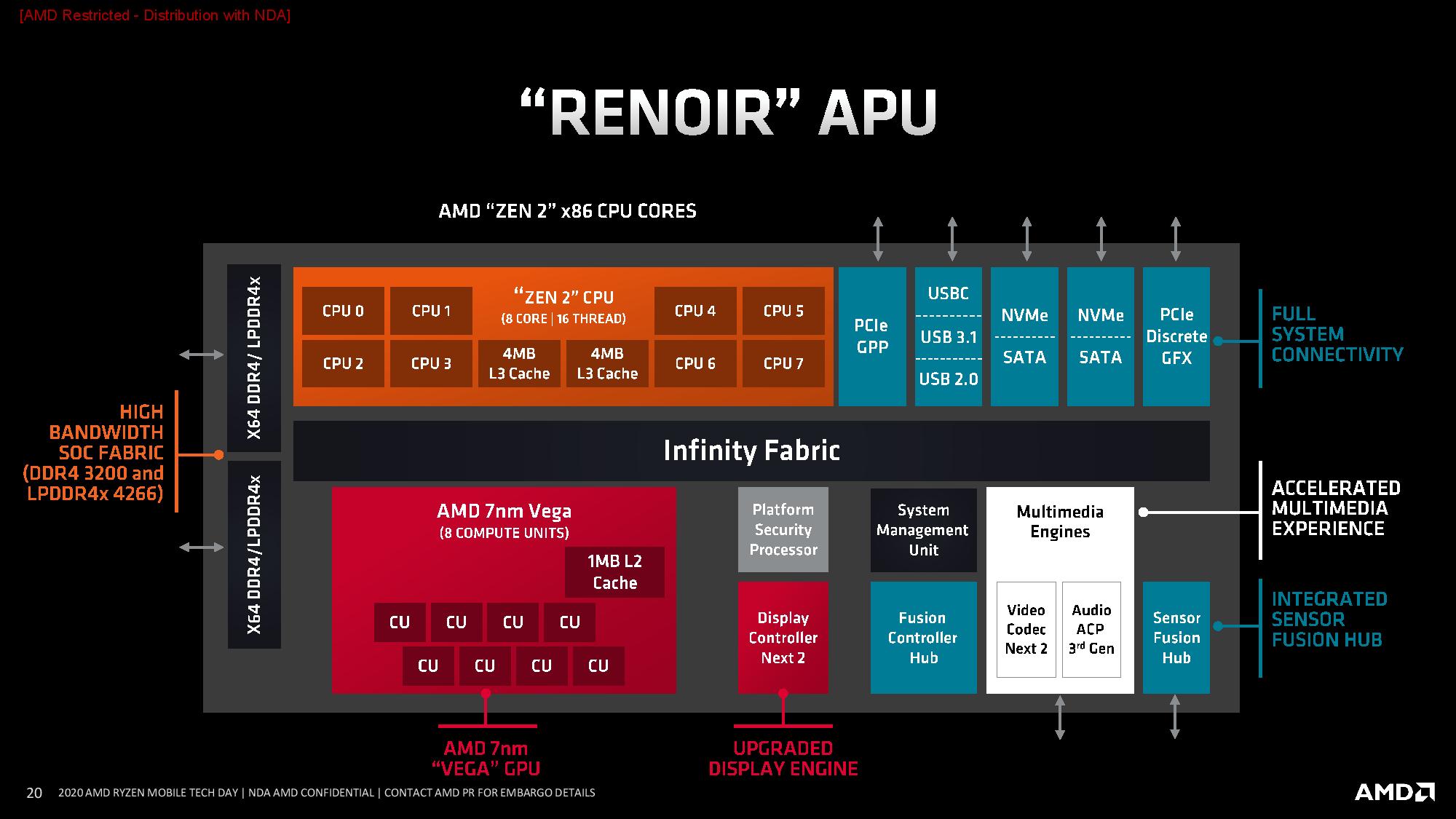
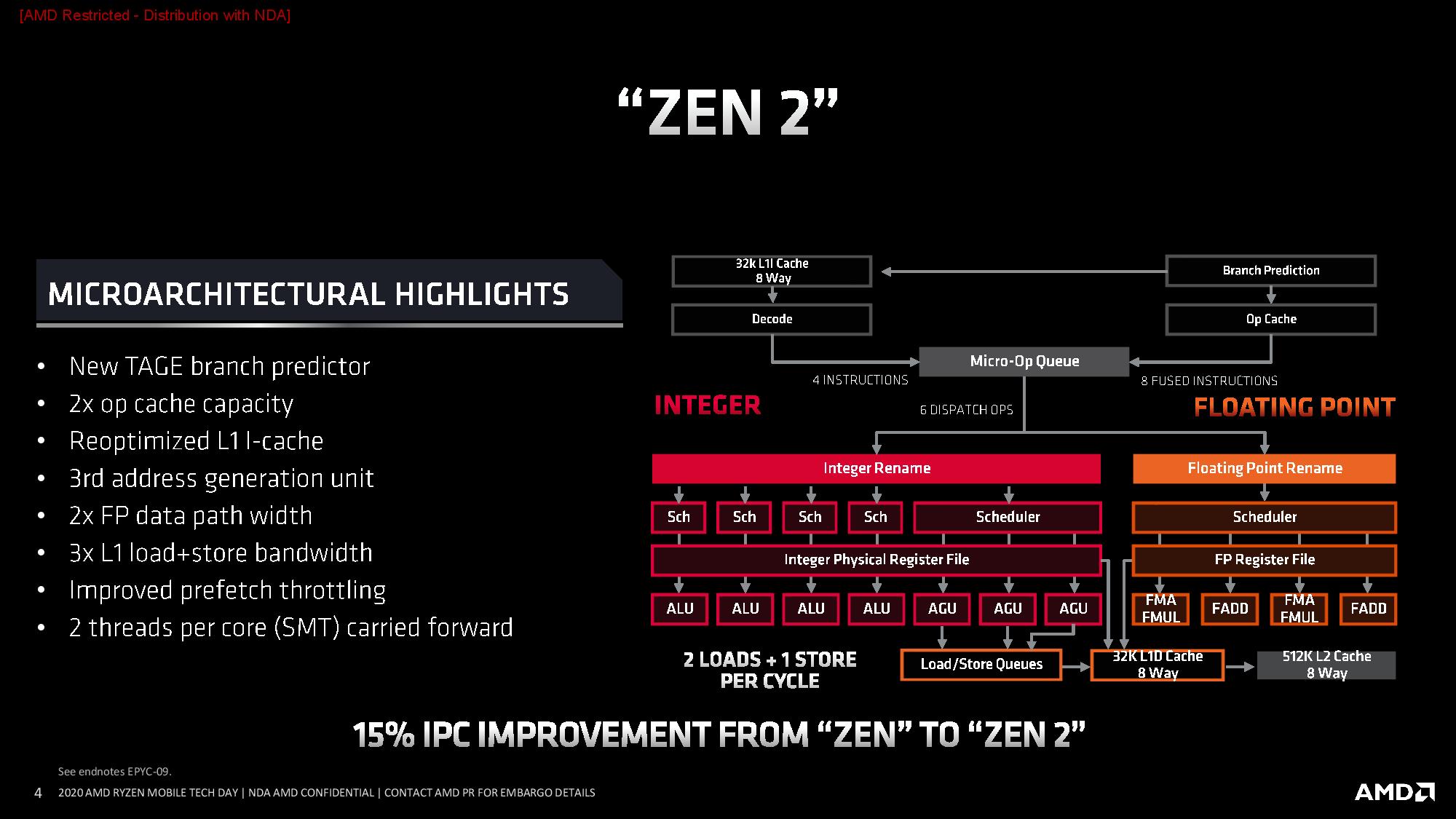
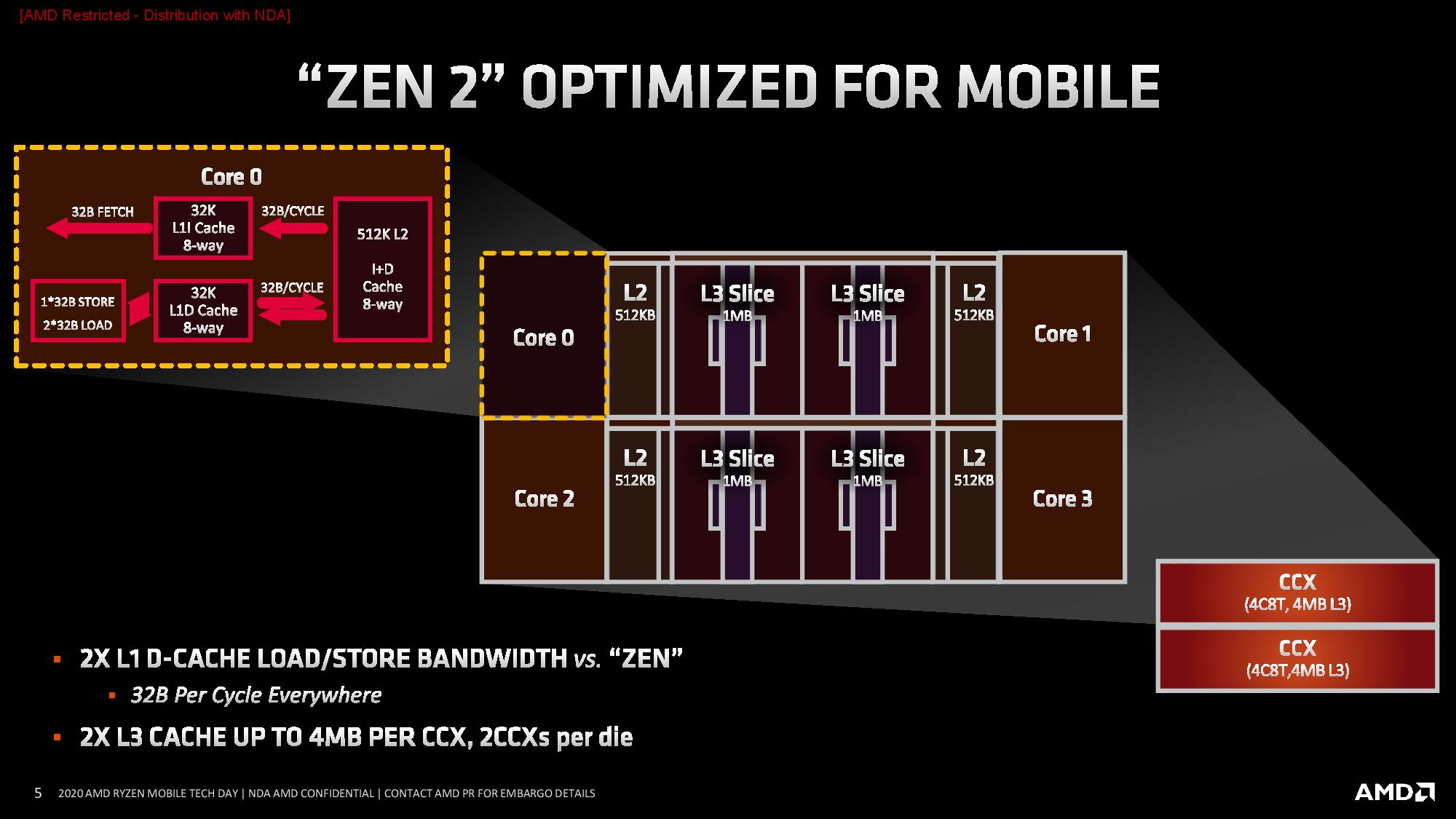
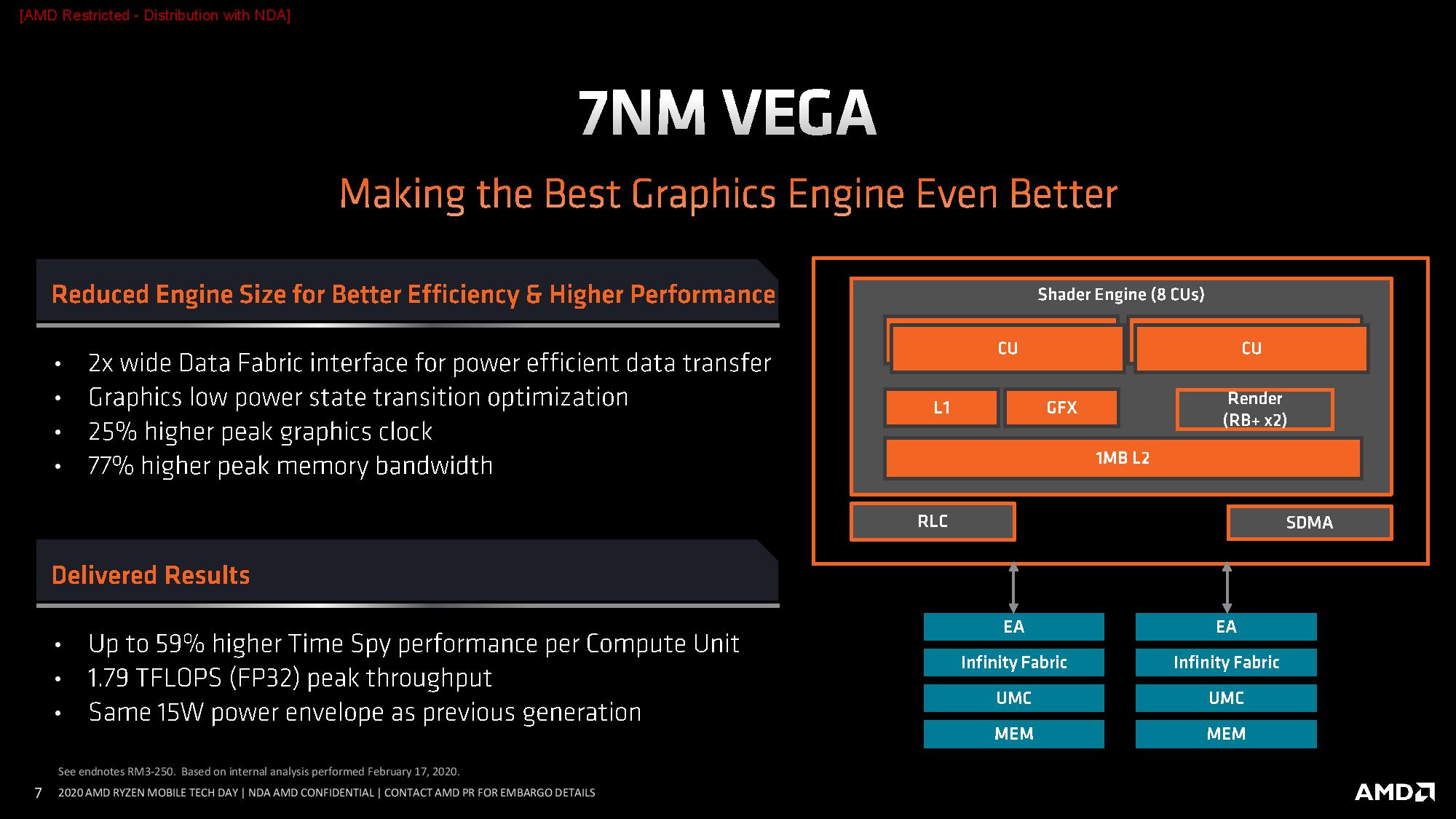
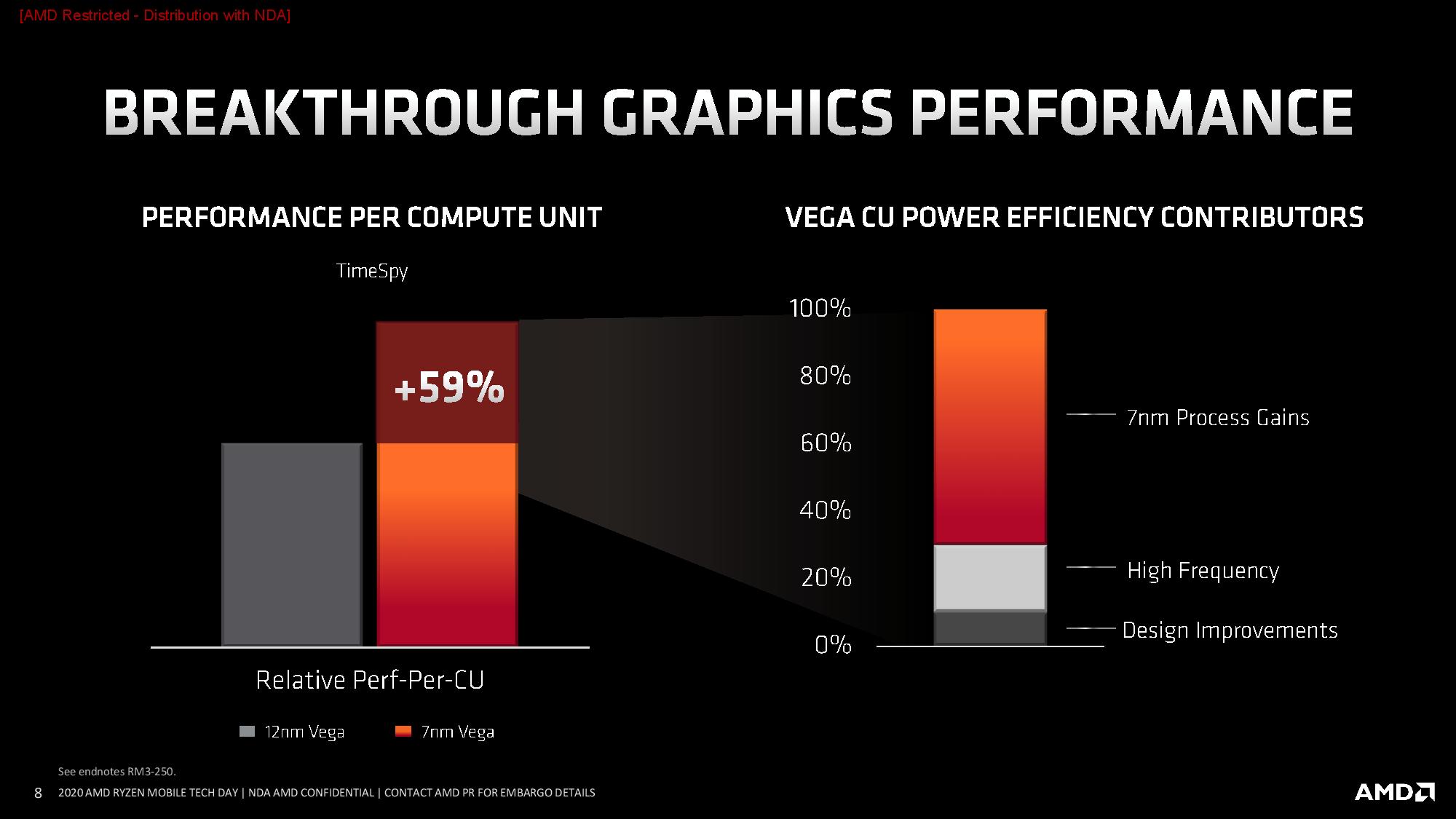
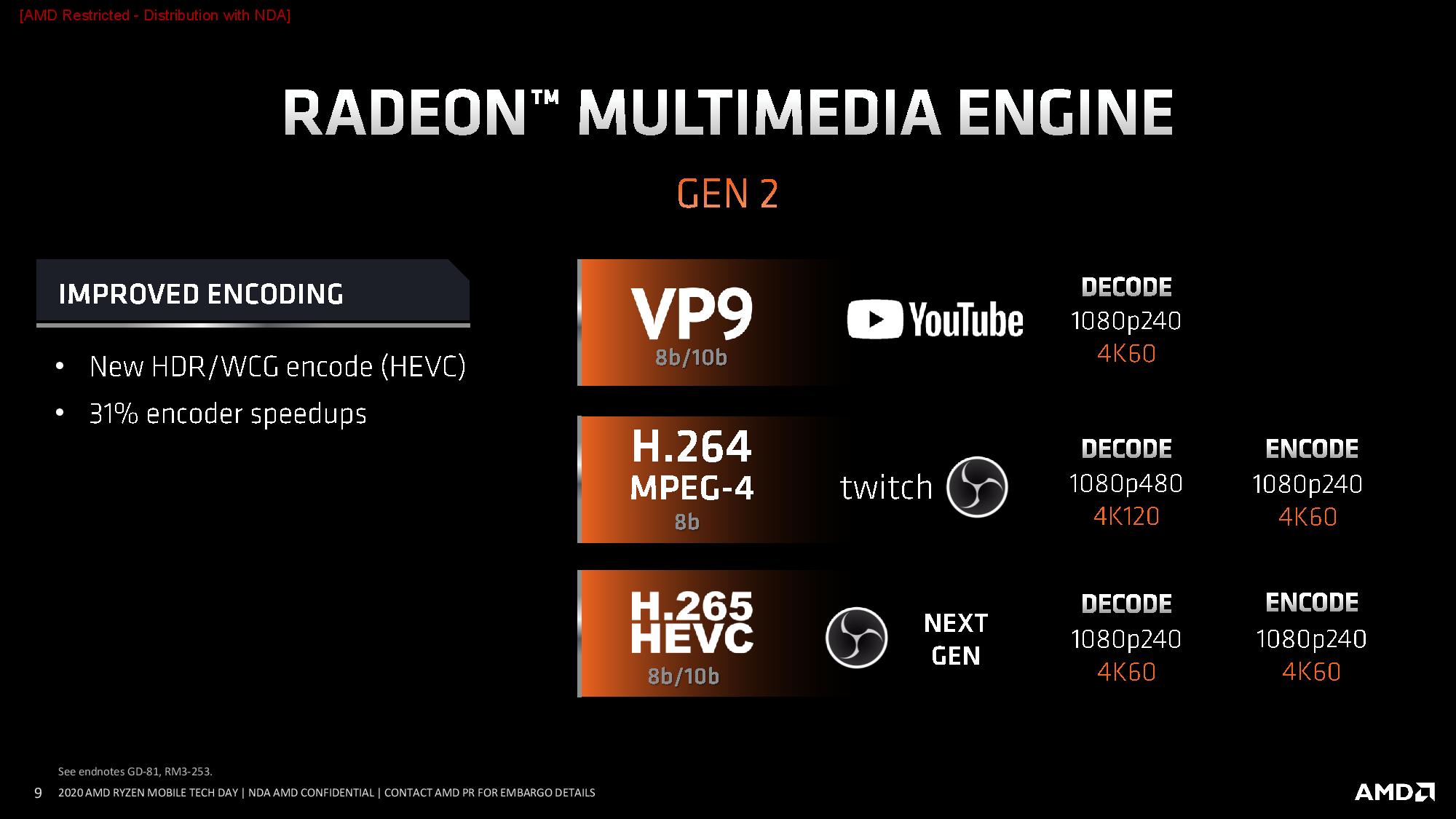
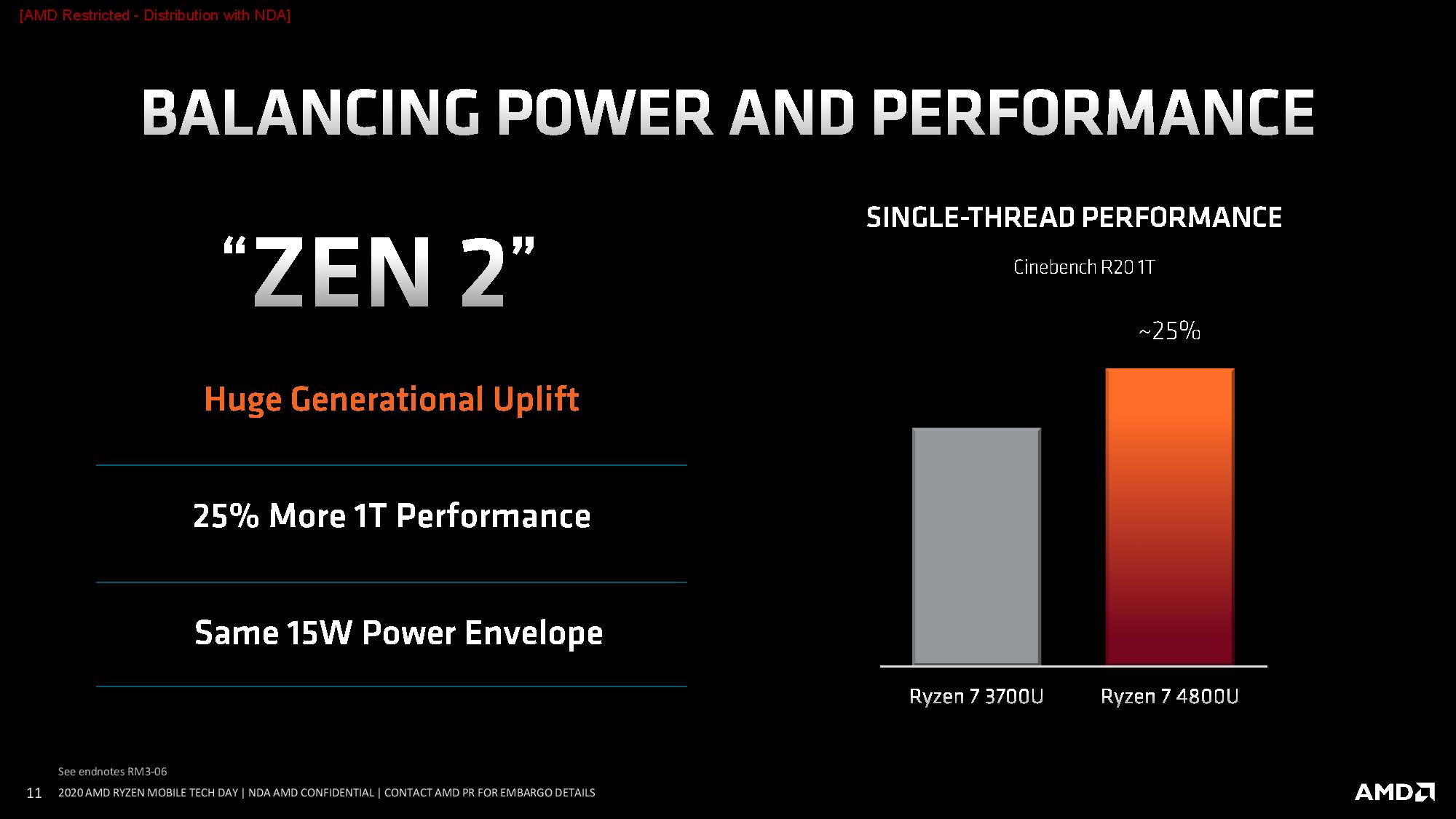
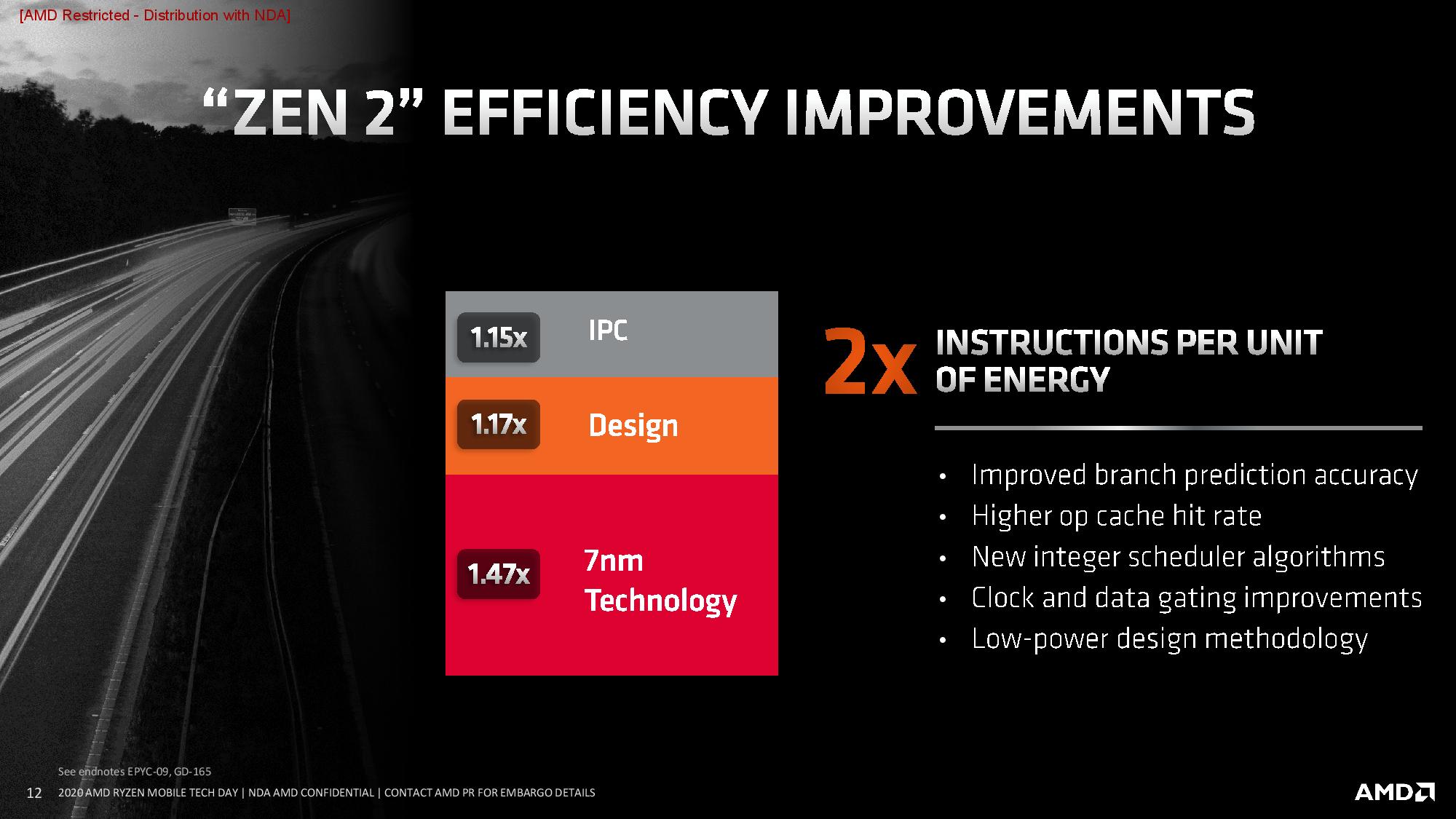
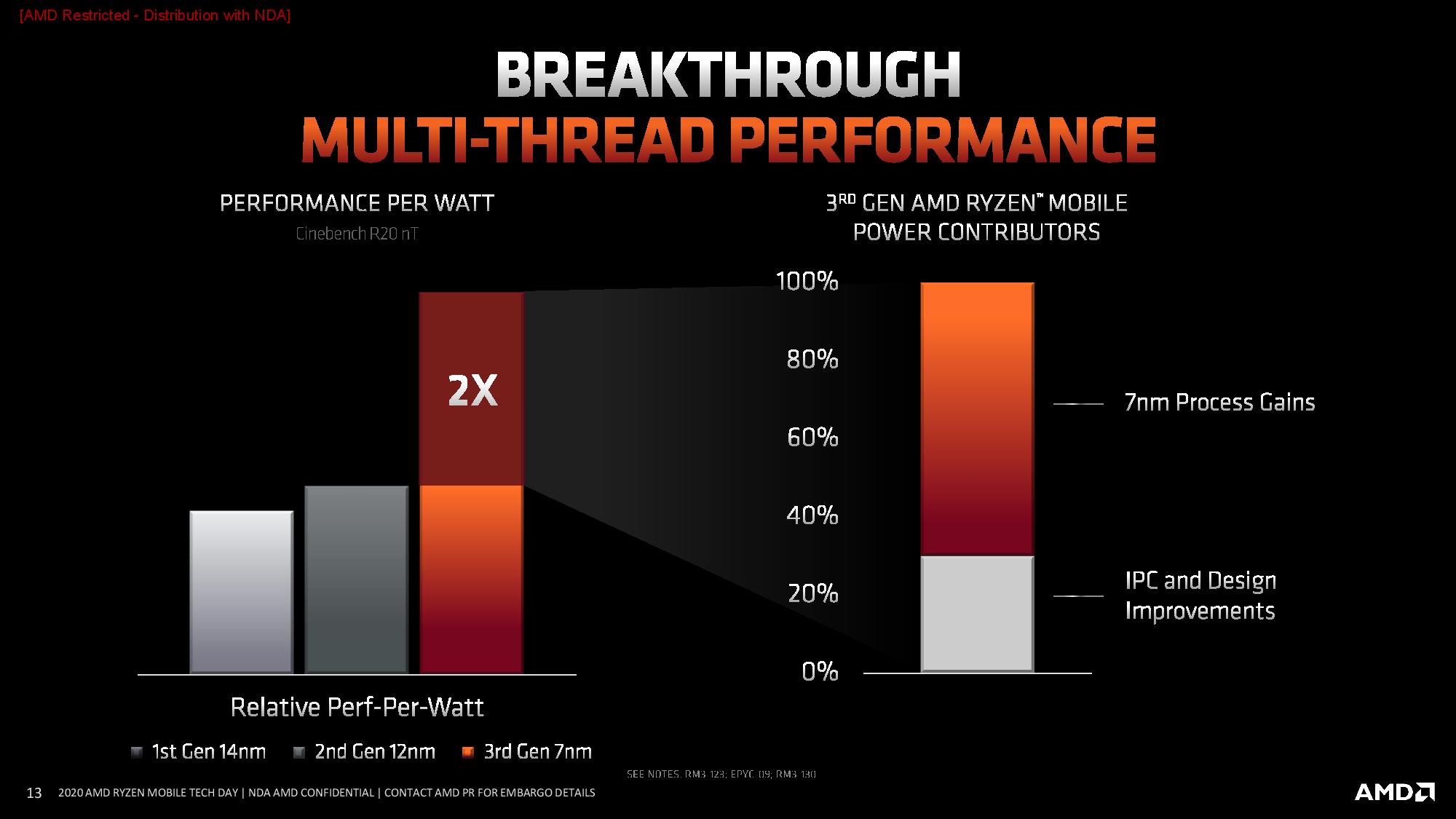
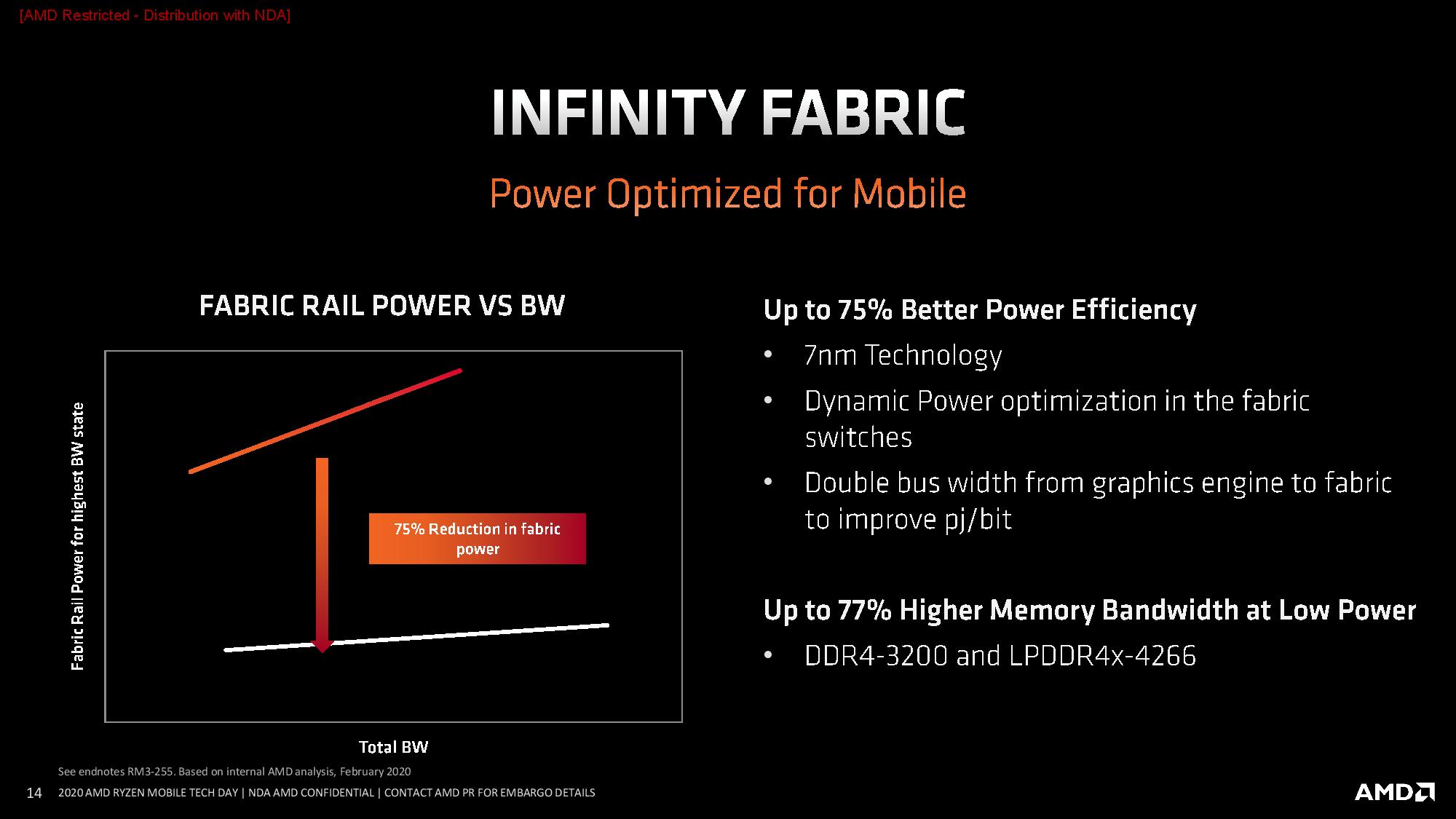
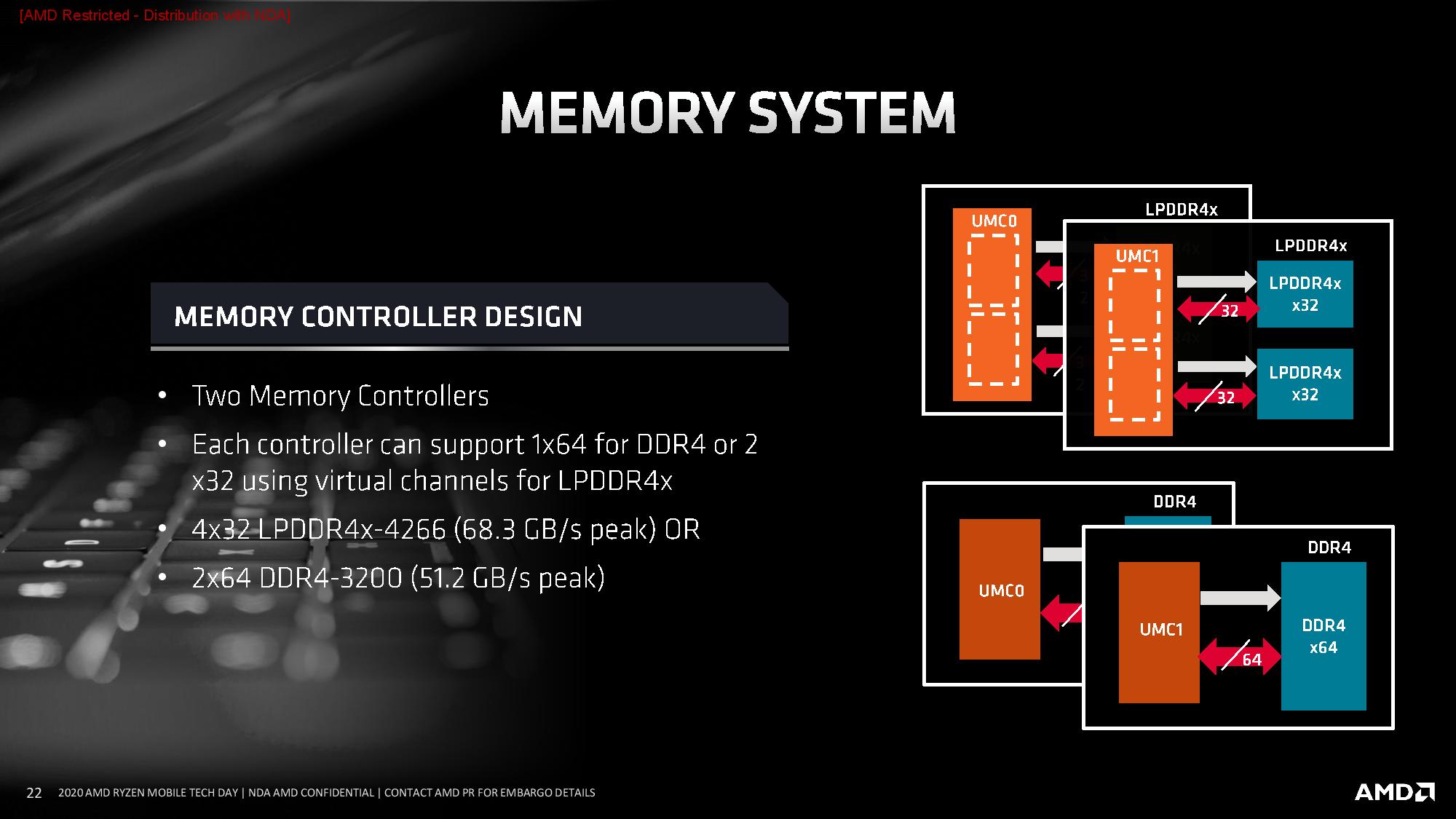
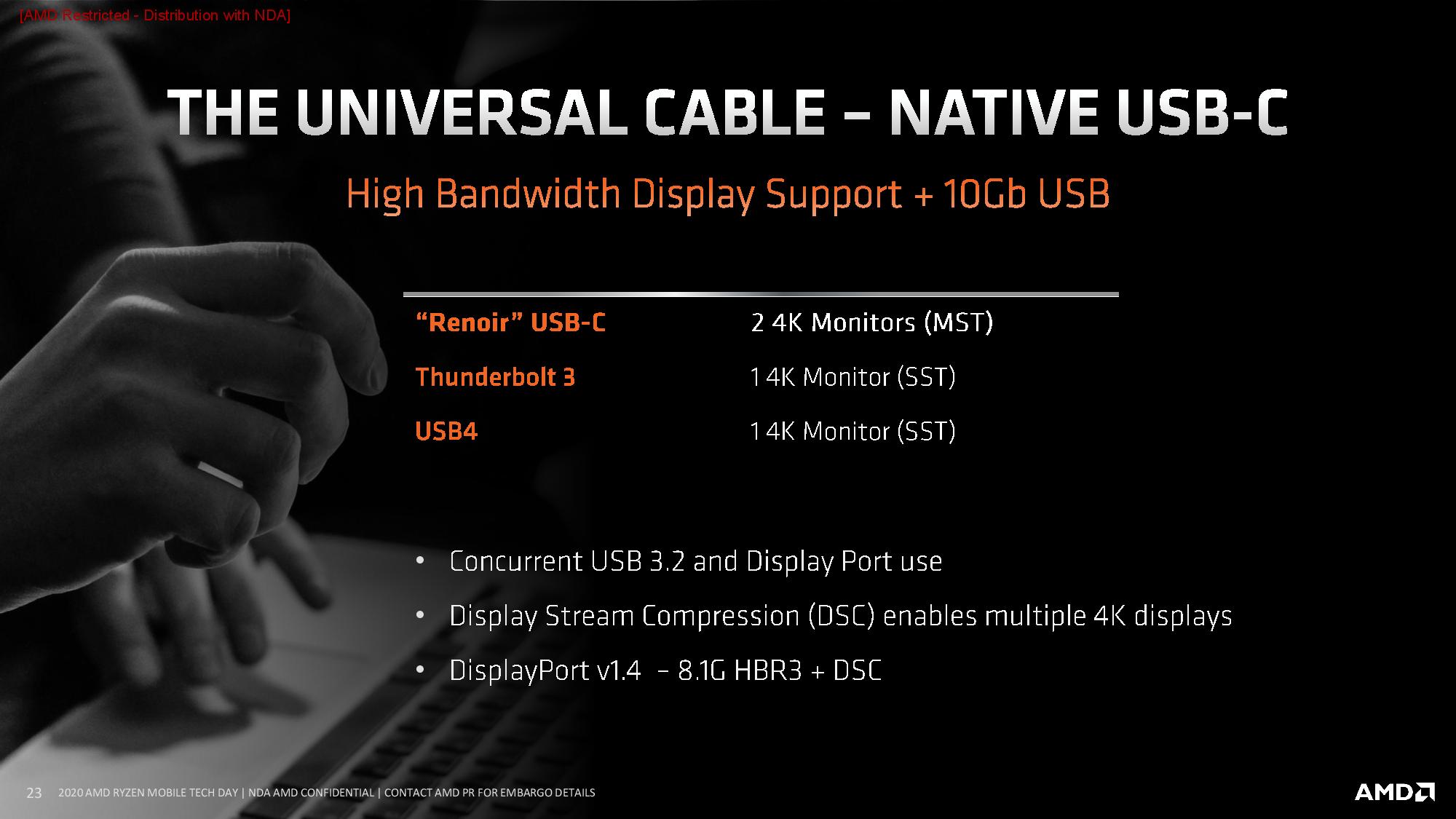
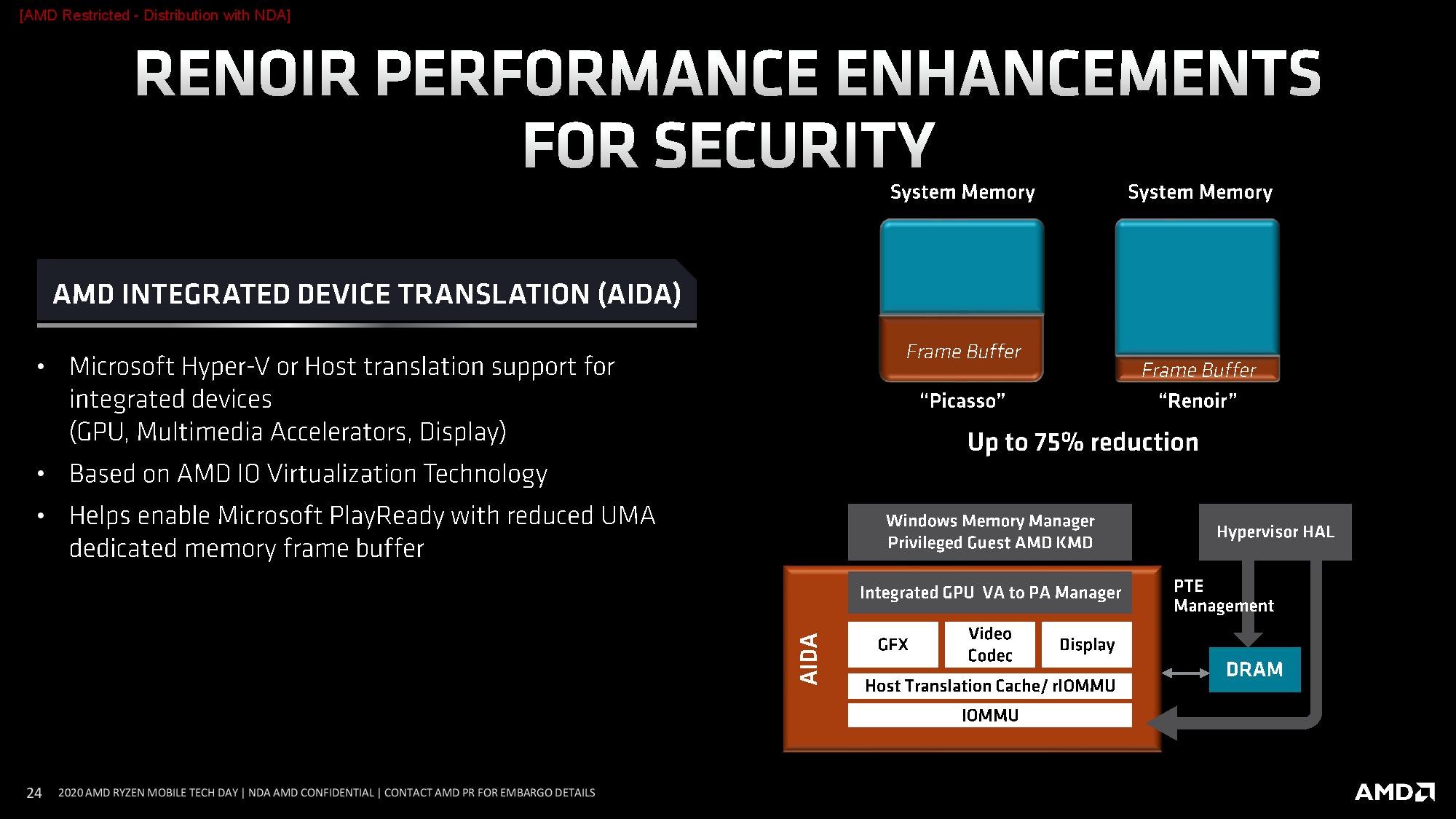
AMD's 7nm Renoir die comes with 9.8 billion transistors, nearly twice the number of transistors found in the previous-gen Picasso chips, packed into a 156mm2 die that is 25% smaller than Picasso. The die is mounted to a 25x25x1.38mm BGA package that AMD says consumes 20% less SoC power and provides doubled performance-per-watt over its predecessor.
The processing cores leverage the now tried-and-true Zen 2 architecture that AMD says brings a 15% improvement in instructions per cycle (IPC) throughput over its previous-gen Zen, with the eight compute cores spread across the standard dual four-core CCX design. On the I/O side, AMD added support for four more lanes of PCIe 3.0 connectivity to enable expanded connectivity, like Wi-Fi 6, 5G, and NVMe storage, along with two additional USB ports.
AMD chose to stick with the Vega graphics engine found in its previous-gen Picasso APUs because its hasn't optimized Navi for mobile yet, but the company chose to make several architectural enhancements when it ported Vega from the 12nm to the 7nm node. That includes reducing the number of compute units (CU) from 10 to eight, but a range of improvements led to an overall performance increase of 59% per CU (based on TimeSpy test results).
Those changes include a 25% increase to the peak graphics clock, and the chip also benefits from up to 77% more memory throughput that comes courtesy of the move to DDR4-3200 / LPDDR4x-4266. The APUs have two memory controllers, with each supporting 1x64 for DDR4, and 2x32 through virtual channels for LPDDR4x memory. The aggregate 4x32 LPDDR4x-4266 channels peak at 68.3 GB/s of throughput, while 2x64 DDR4-3200 peaks at 51.2 GB/s.
To accommodate that increased throughput, AMD doubled the width of the Infinity Fabric interconnect that ties the chips' units together. AMD says the improved bandwidth improves interconnect power efficiency (as measured by pj/bit), and new dynamic power states, which allows the fabric to drop into lower-power states and alter width on the fly, provides up to 75% higher power efficiency.
The culmination of these efforts provides up to 1.79 TFLOPS of peak FP32 throughput, an accomplishment that falls within the same 15W envelope as Renoir's predecessor. AMD says the lion's share of the improved power efficiency stems from the move to the 7nm process, but that higher frequency and architectural improvements also play a role.
AMD also updated its Radeon multimedia engine (Display Controller Next 2) with (up to) a 31% improvement in encoder performance. The chips support VP9 8b/10b decode at either 1080p240 or 4K60, along with both encode and decode for H.264 and H.265.
Ryzen 4000 APU Power Consumption
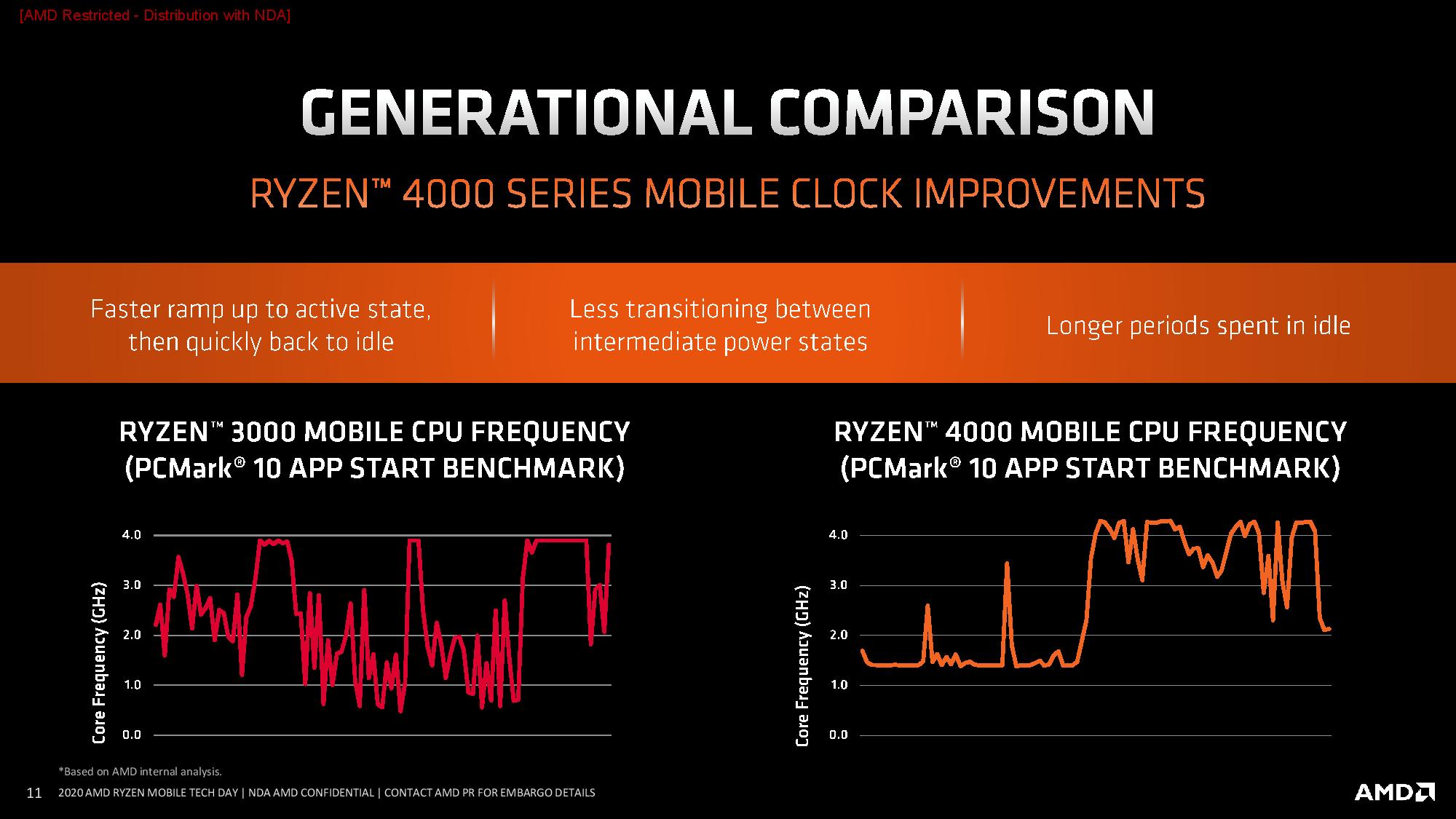
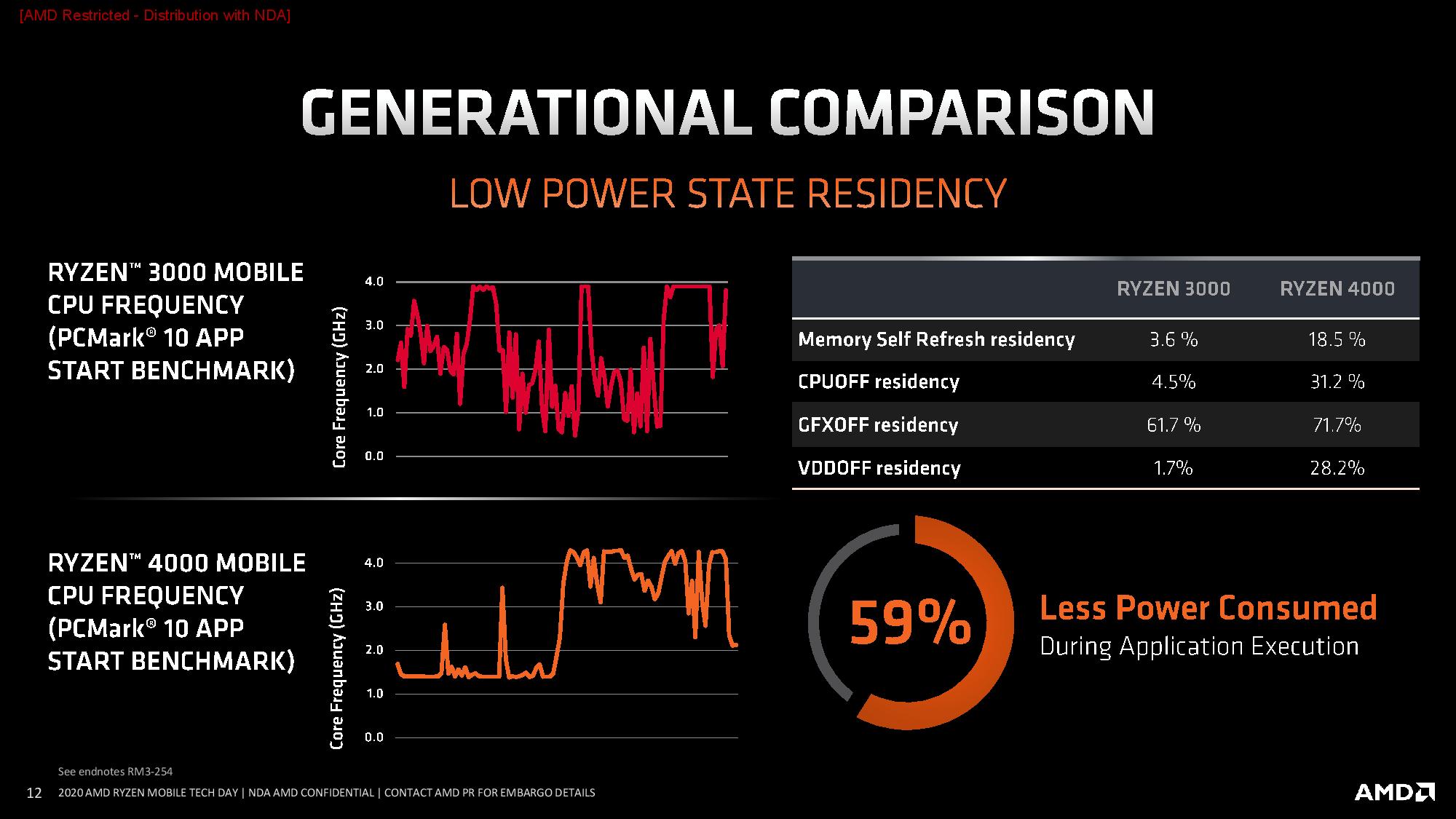

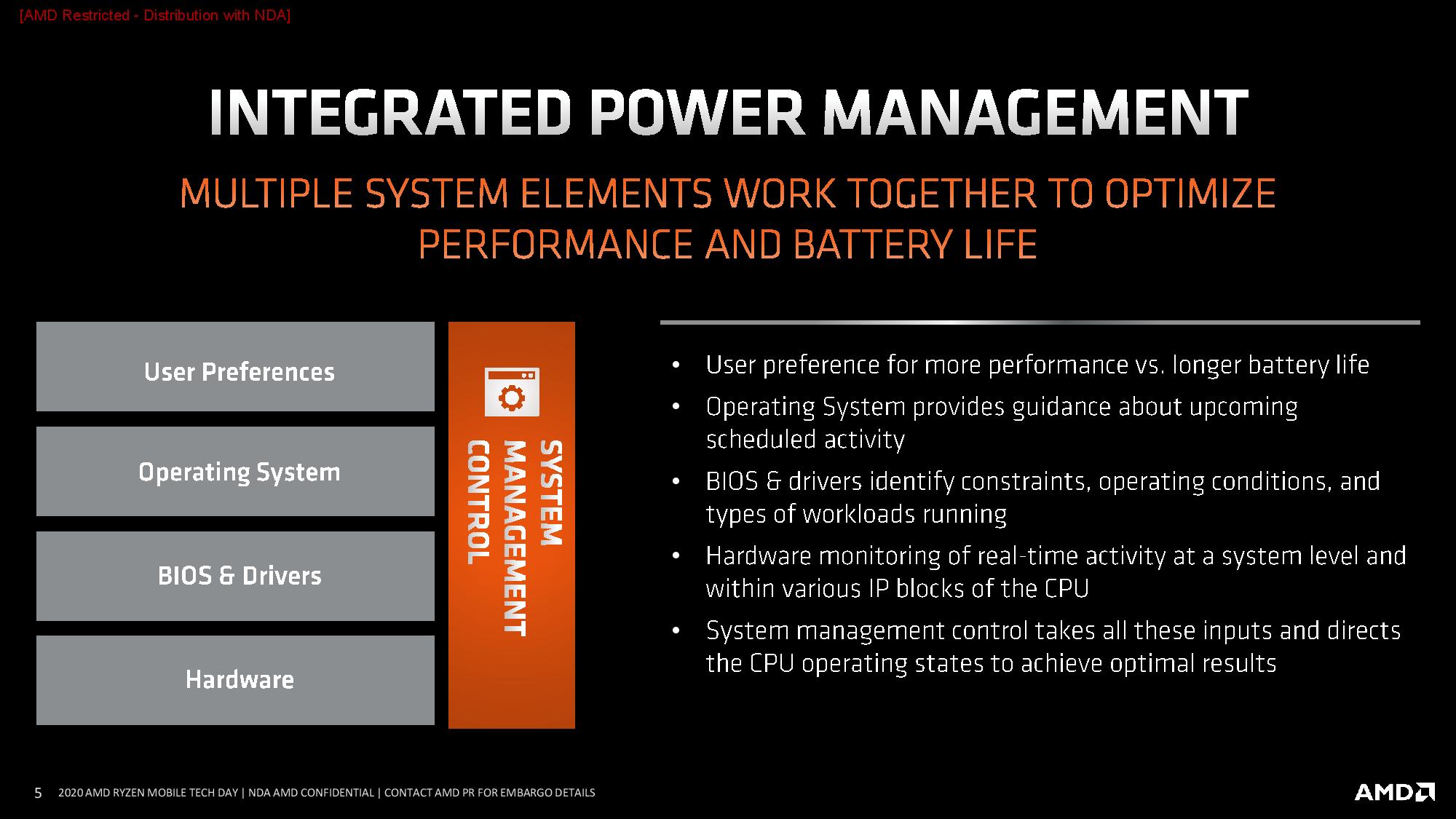
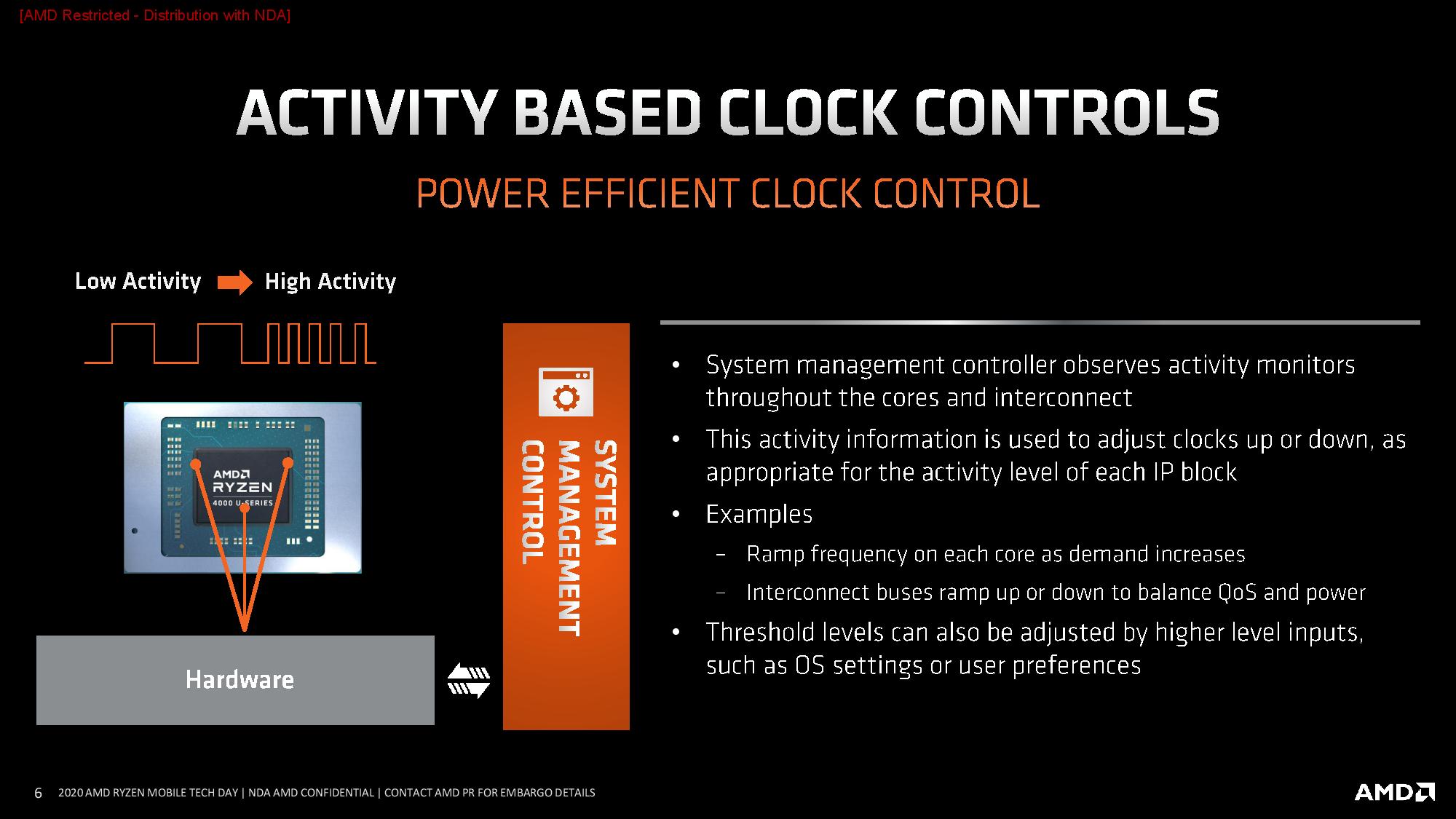
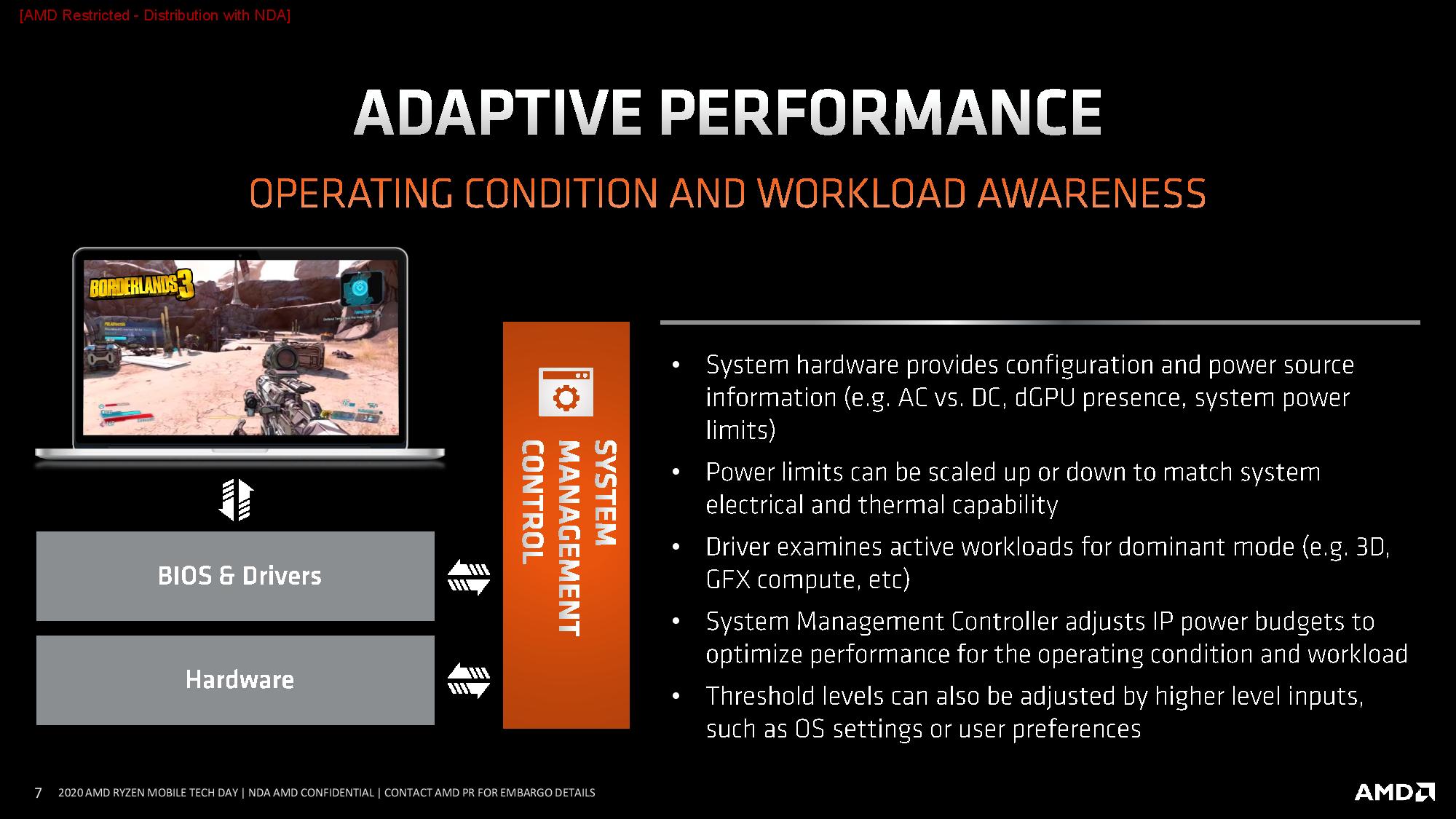

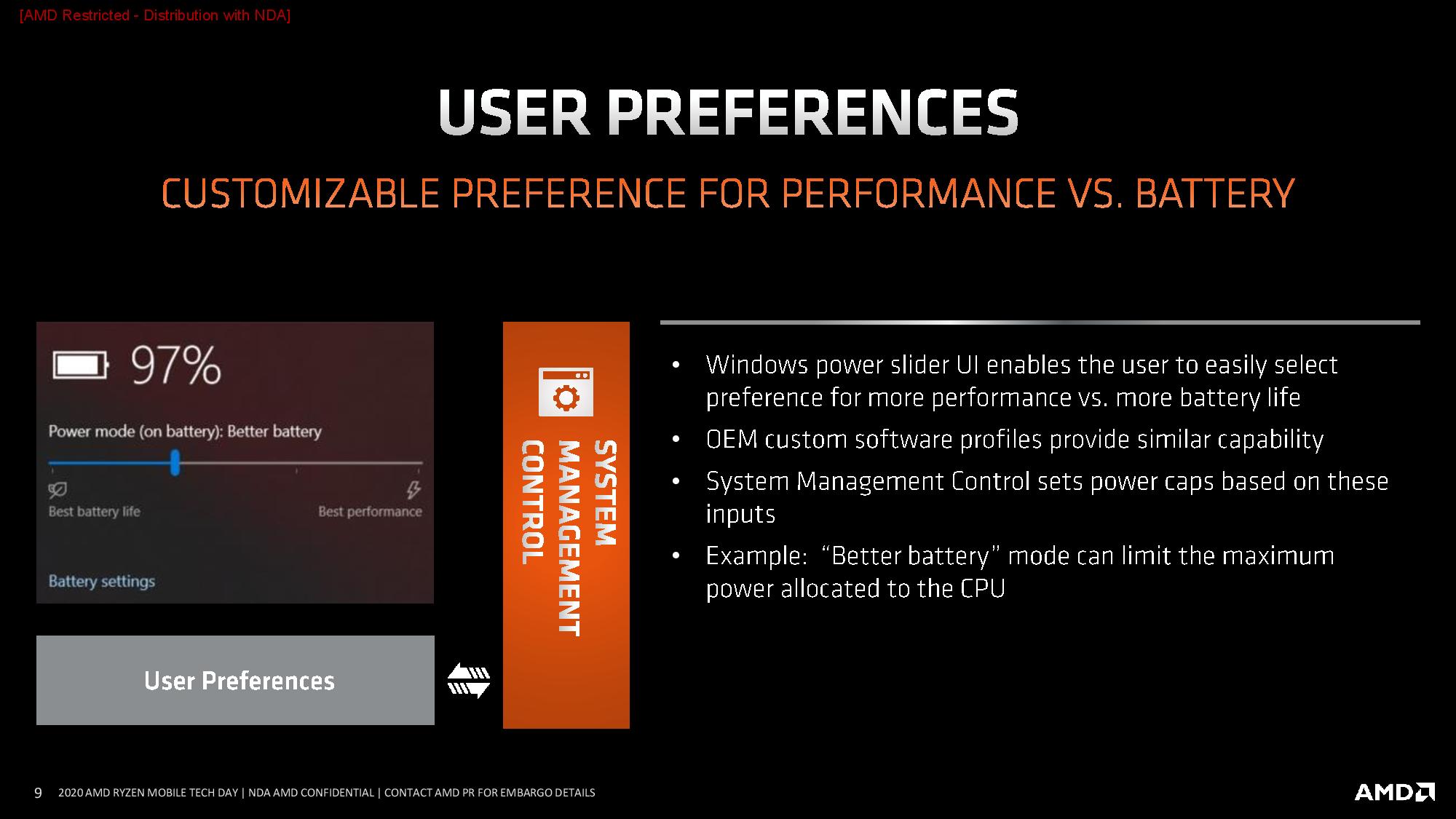
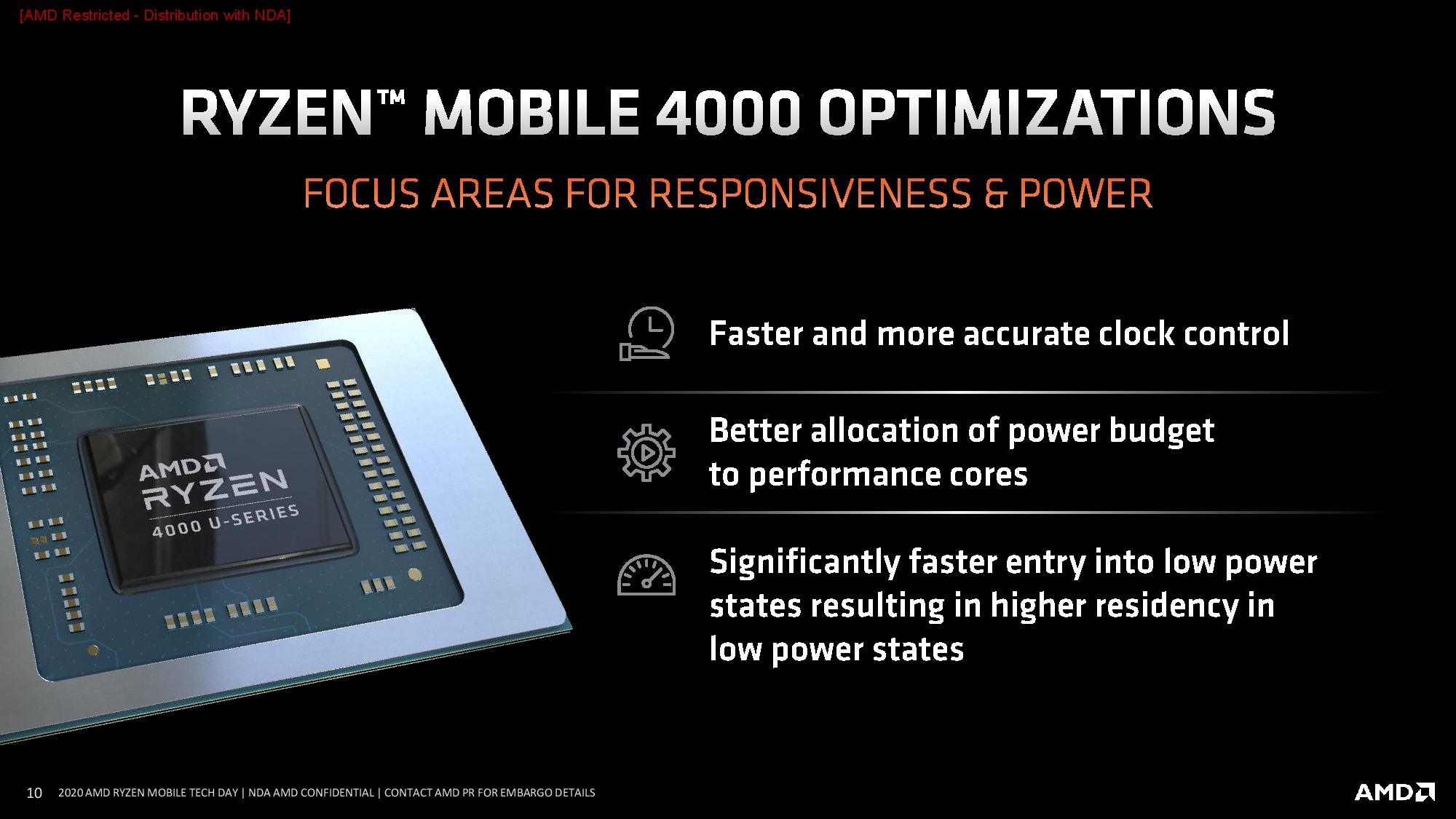
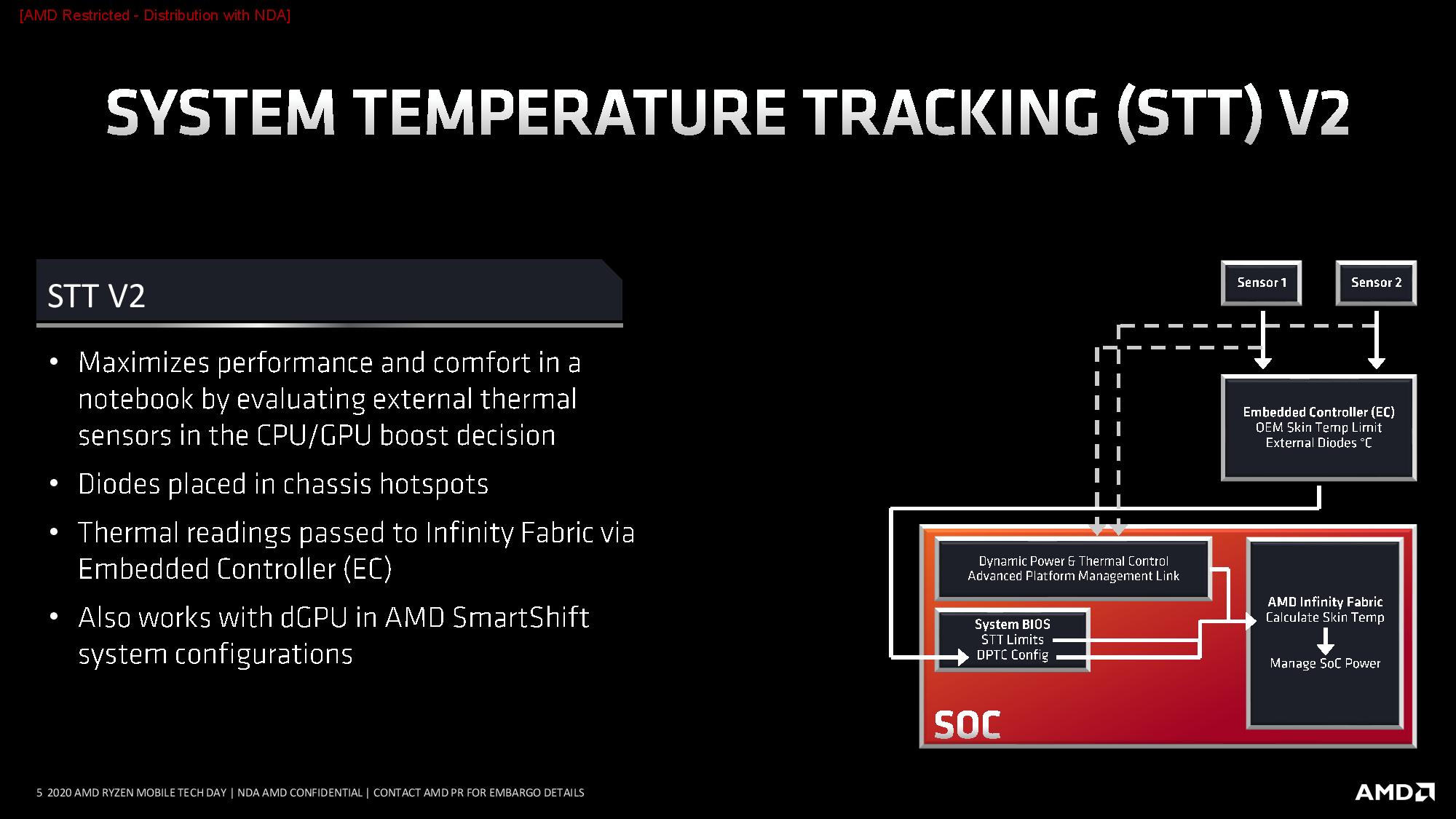
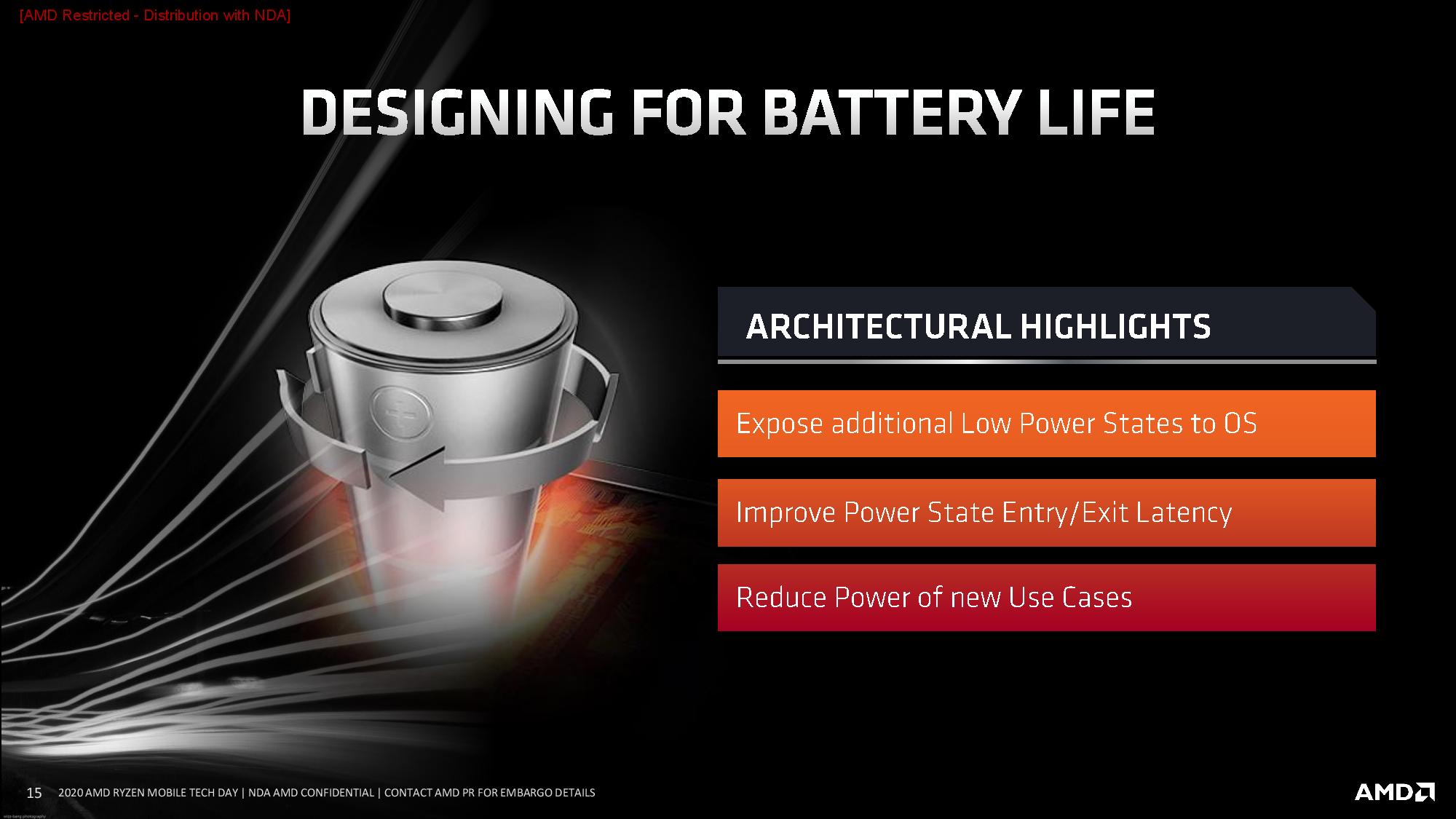
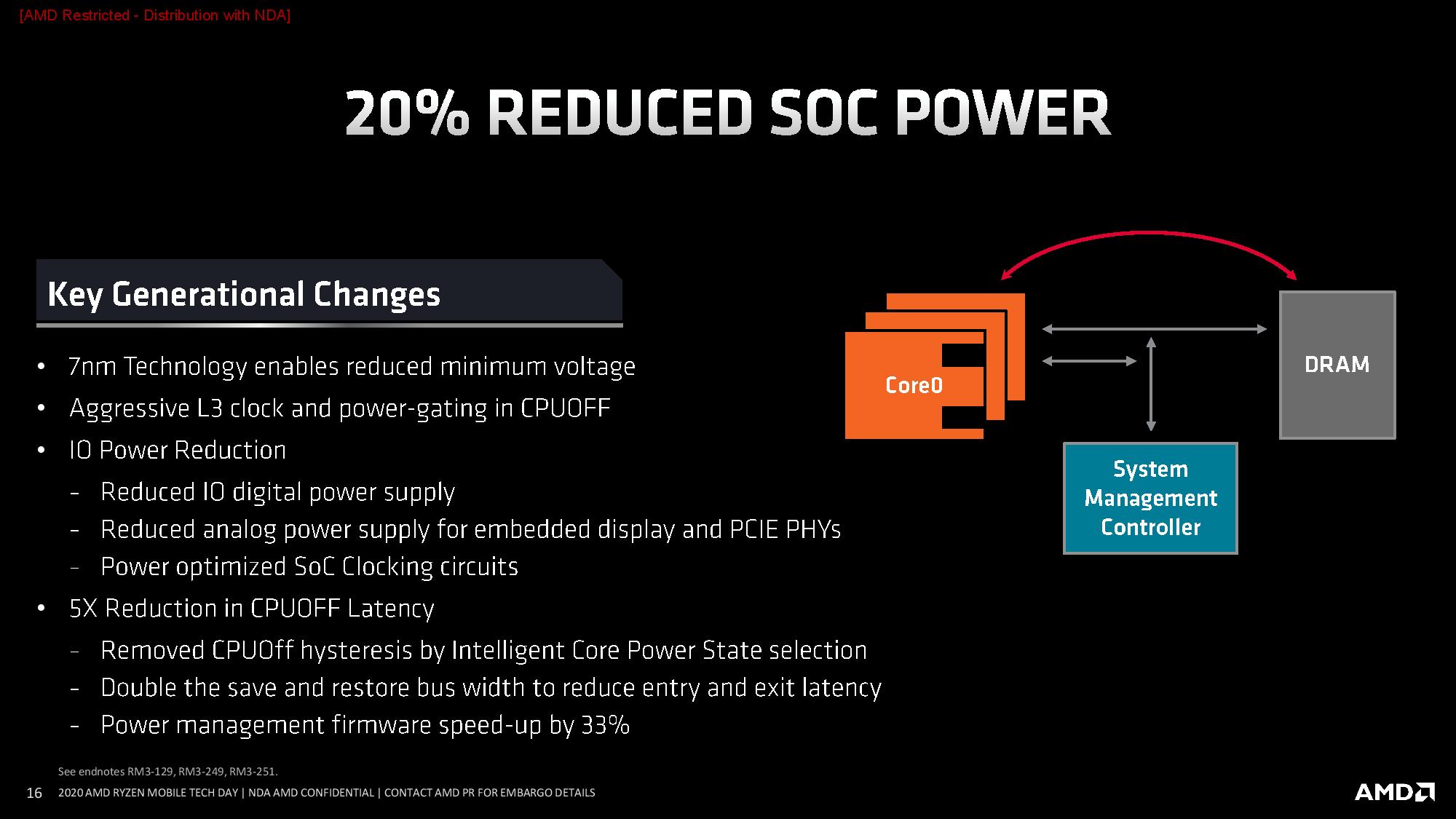
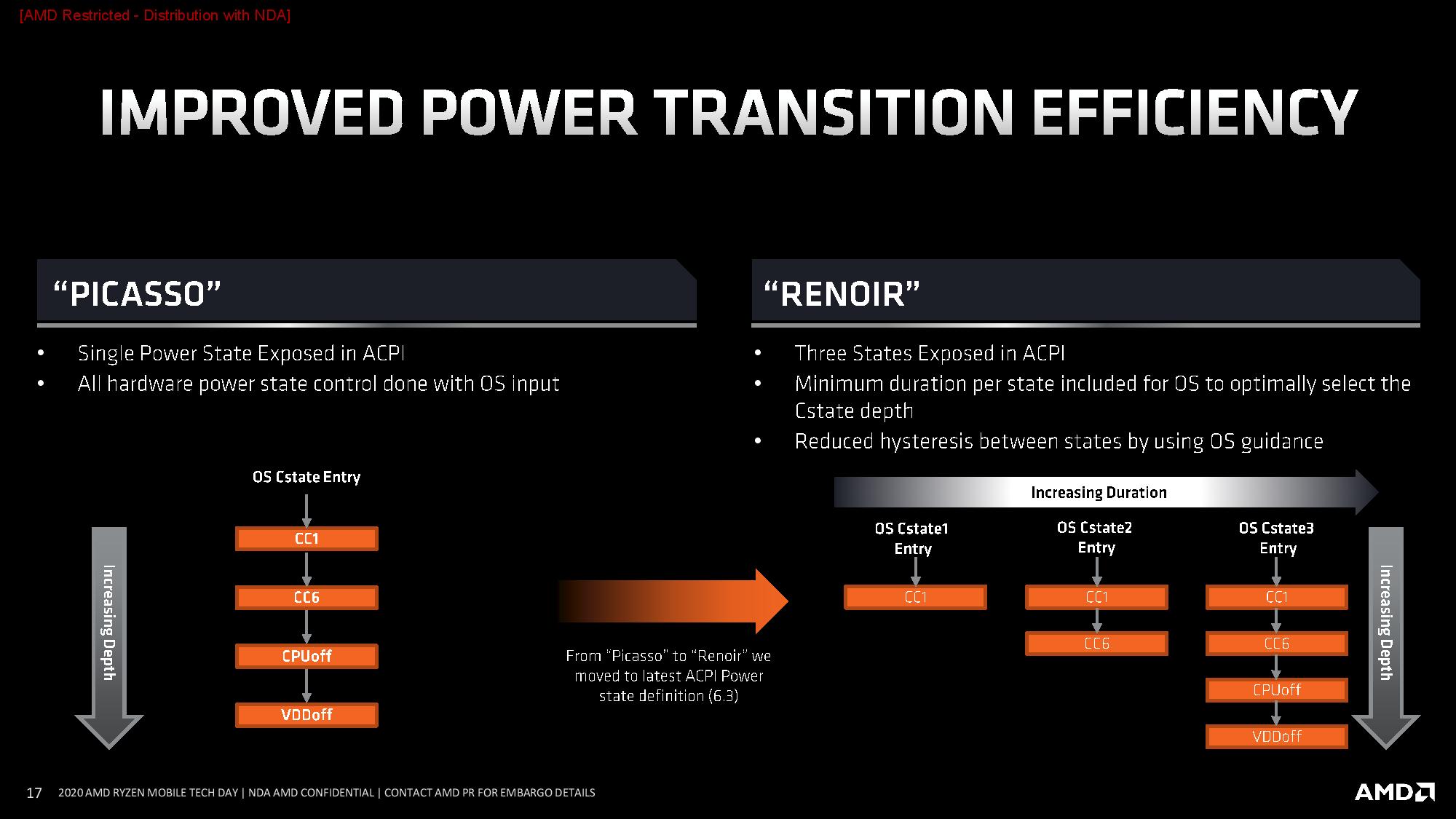
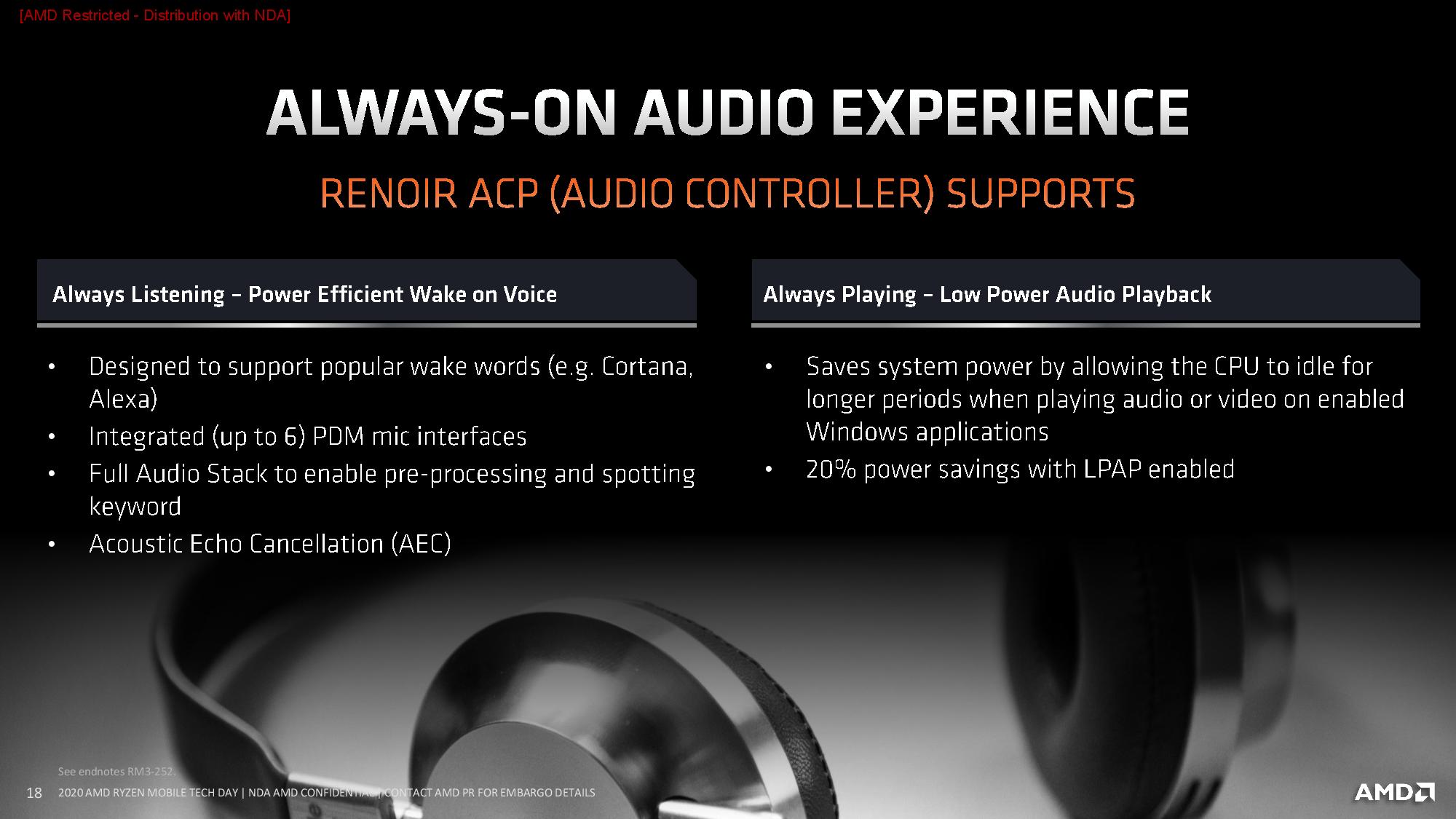
Controlling power consumption can be a dizzying affair in desktop chips, with thermal and electrical conditions of the chip dictating many of the power state transitions, while interactions with the operating system, BIOS and drivers all combine to help the chip modulate performance. That, in turn, dictates both frequency, sleep states, and overall power consumption. Moving that chip to a battery-powered laptop requires yet another level of sophistication that AMD addresses with a more holistic system-level approach.
AMD improved the Renoir chips by leveraging its established power state paired with two additional ACPI power states, enhanced telemetry data fed through the Infinity Fabric and the system management controller, maximizing power allocation to the cores, and 5X faster entry/exit times for idle states.
The net effects of these adjustments results in better power efficiency, in part due to a more clear delineation between idle and full-power states, thus eliminating unnecessary power-sapping intermediate power states. As an example, AMD provided before-and-after CPU frequency plots during the bursty PCMark 10 benchmark, highlighting that the processor spent more time in various idle states that resulted in 59% less power consumption during the test.
AMD's innovative Precision Boost technology, which extracts the utmost performance from each core based upon its individual capabilities, is a key technology that provides the best mixture of power and performance possible, but AMD has also developed a technique to better modulate performance and power consumption in mobile form factors.
AMD Skin Temperature Aware Power Management (STAPM) allows the CPU to adjust its boost duration based on external temperature sensors placed on the laptop's hotspots (typically by the CPU, GPU, or power delivery subsystem). Data from these sensors is fed to the embedded controller (EC), which then transmits the telemetry data across the Infinity Fabric to the SoC. The Advanced Platform Management Link (APML) then reports the data and sets the CPU thermal registers (essentially stores the data).
The Dynamic Power and Thermal Control (DPTC) interface allows external sources to adjust SoC power controls on the fly, so the system can use the data gathered from the sensors to trigger short high-frequency boosts that exceed the normal power limit, which is helpful during bursty workloads.
AMD's latest advance extends that benefit to longer boost duration periods. The System Temperature Tracking V2 (STT V2) feature manages power state transitions based on a multitude of factors, like the external skin temperature, allowing the laptop to sustain up to four times longer boost periods without becoming uncomfortably hot for the user. Notably, Intel's modern laptop processors take a similar approach of adjusting power states based on external temperature sensors.
AMD's Picasso APUs only came with support for one ACPI power state to dictate how long the processor resides in various C-States, but the 4000-series chips come with three states. That enables finer-grained control of the various states, thus allowing the SoC to make better decisions that translate to improved power efficiency and battery life. AMD also doubled the save and restore bus width to reduce the time it takes to enter and exit the various states and sped up its power management firmware by 33%.
An activity-aware implementation also allows the SoC to adjust various units based on usage to attain the right mixture of performance and quality of service, but users can adjust these parameters via the power control slider in the operating system. Paired with reduced I/O power consumption, AMD says the SoC consumes 20% less power than its predecessor.
AMD 4000-Series Renoir APU SmartShift
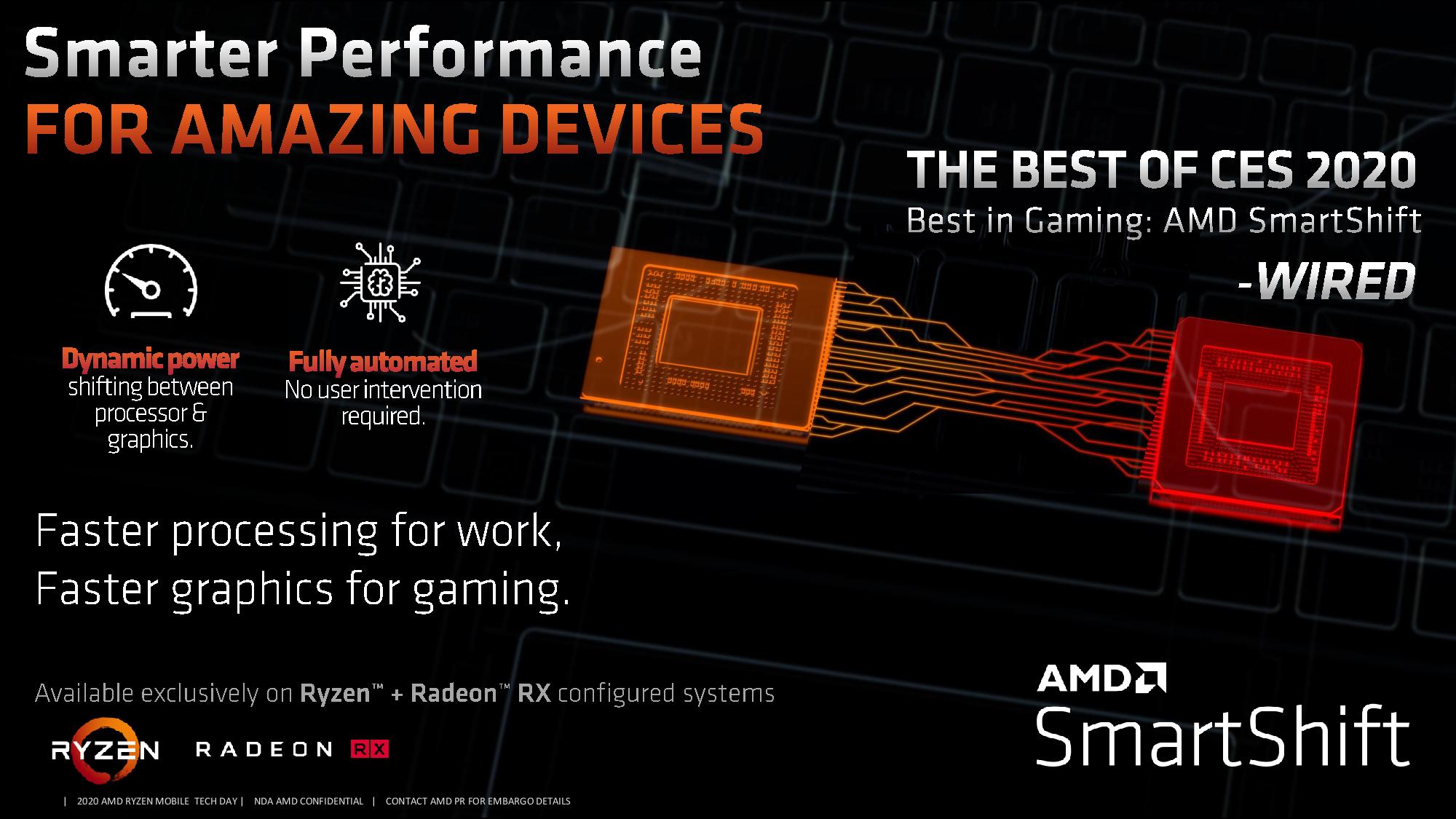
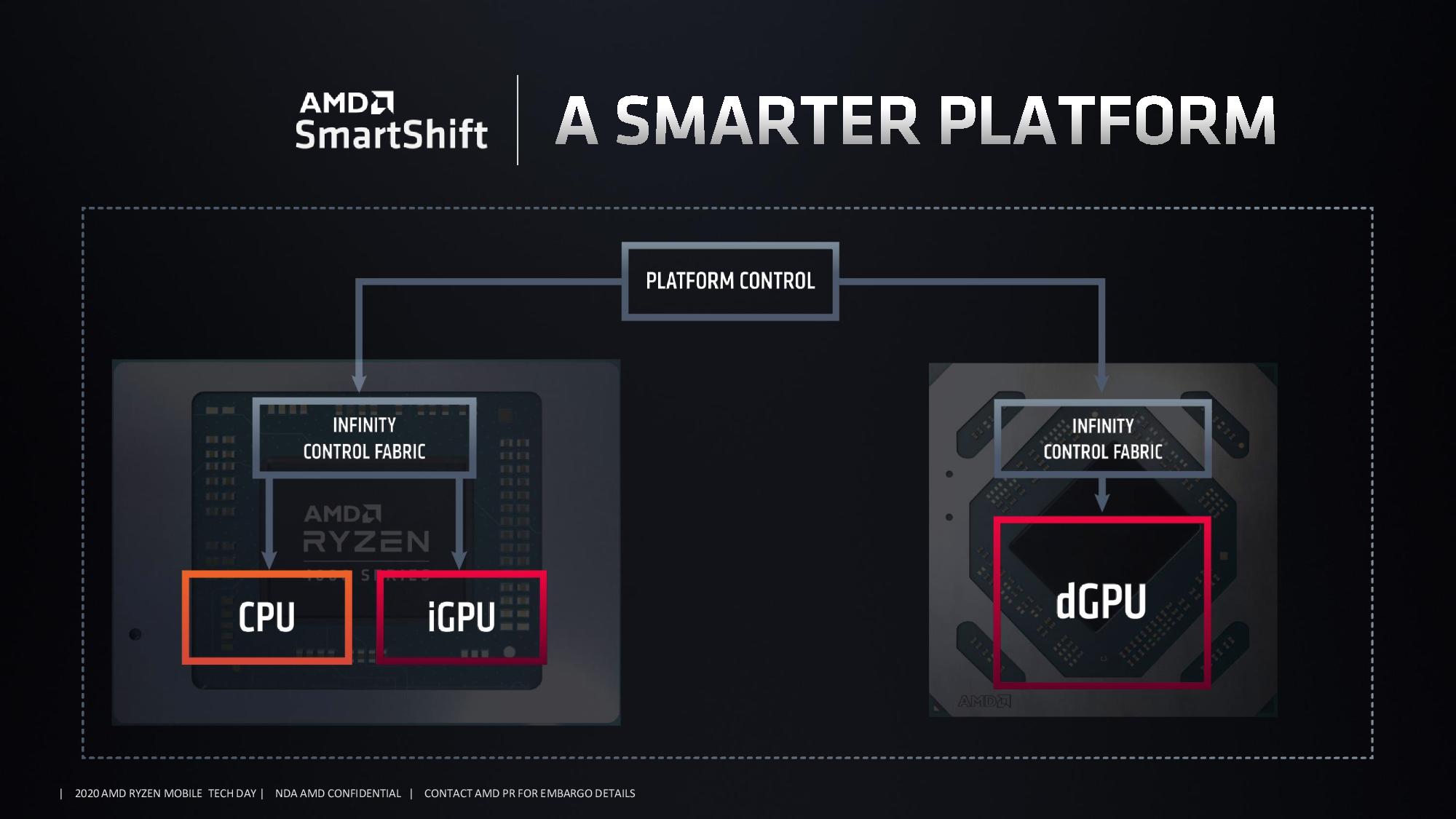
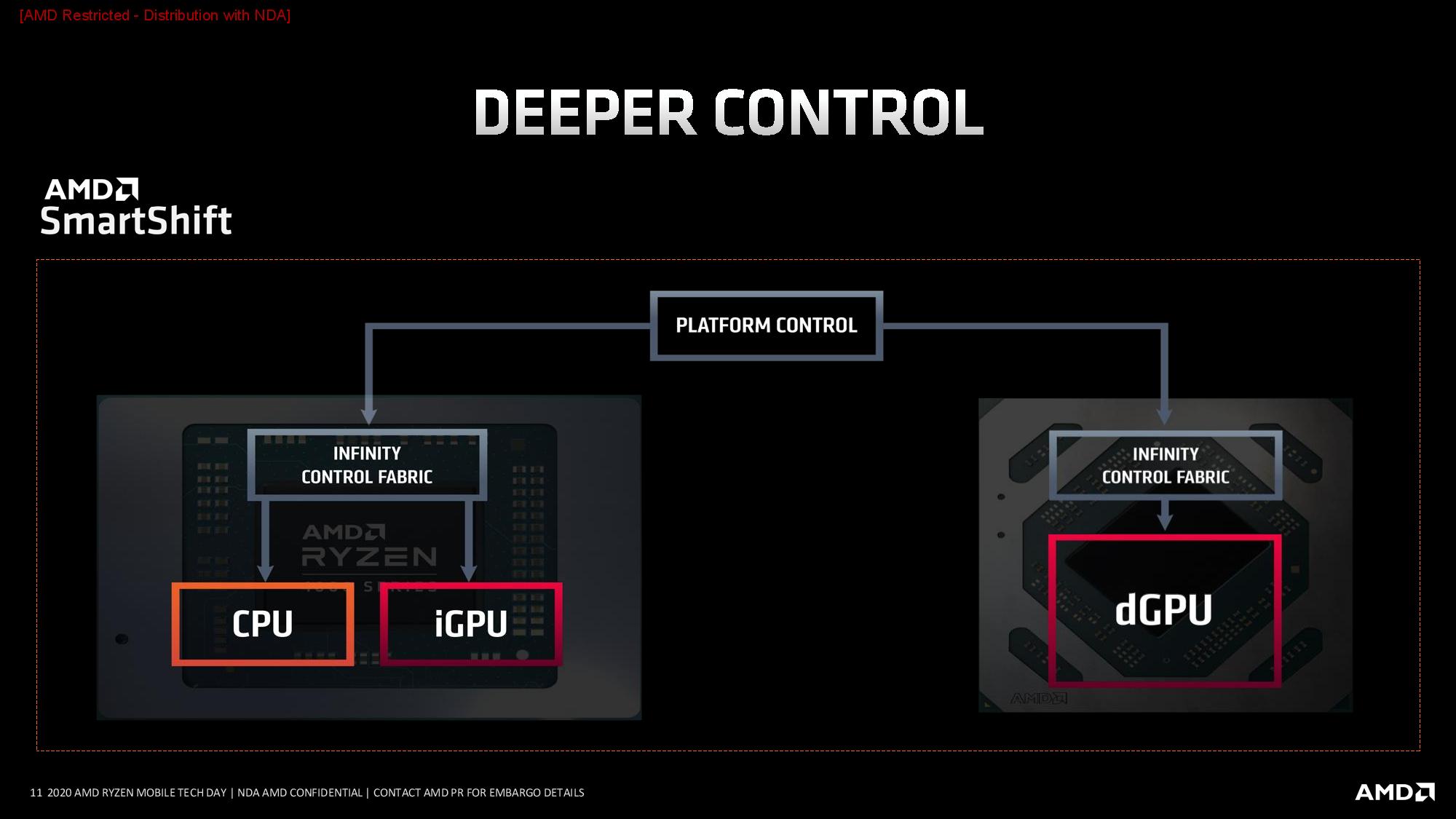

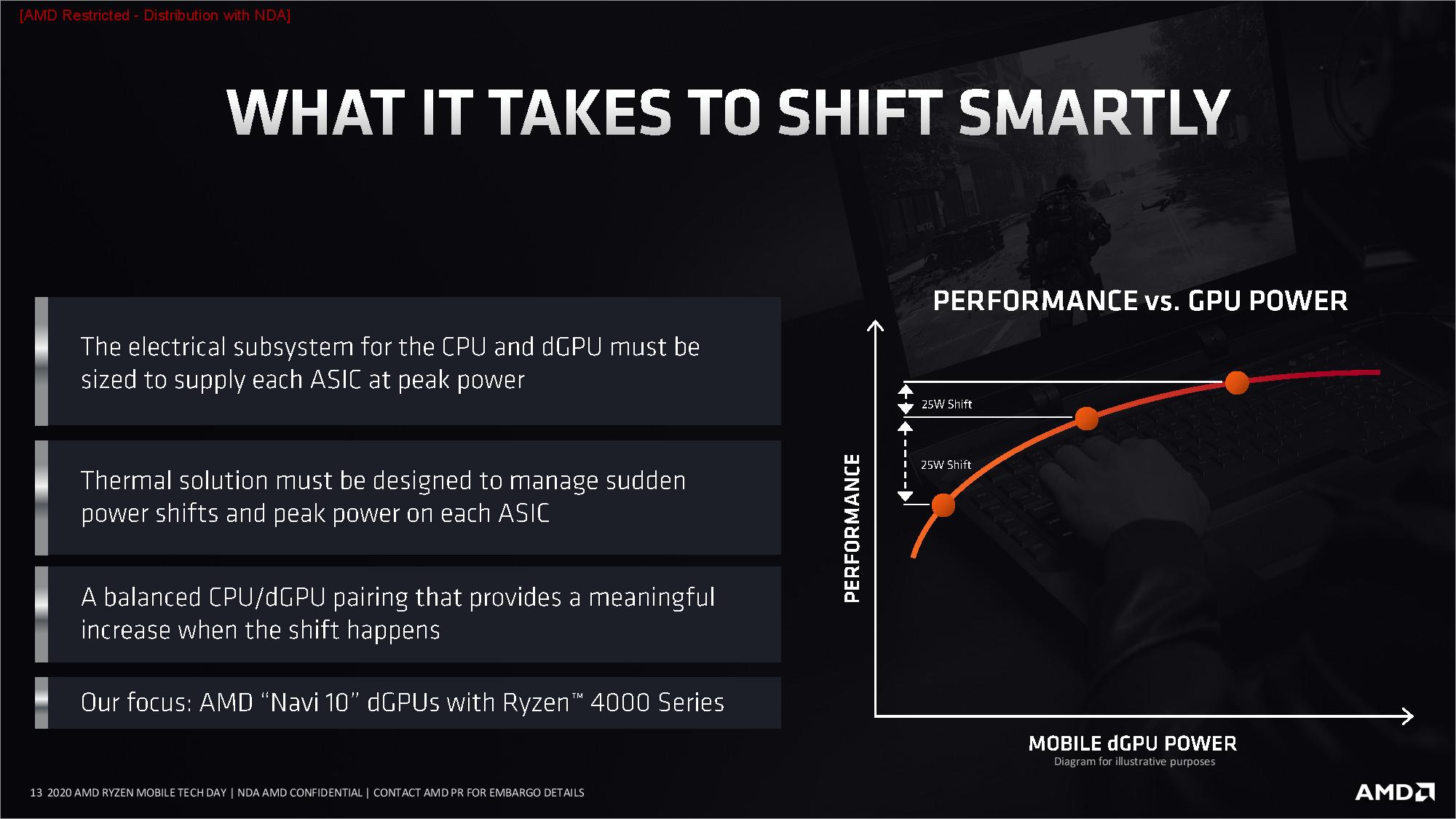

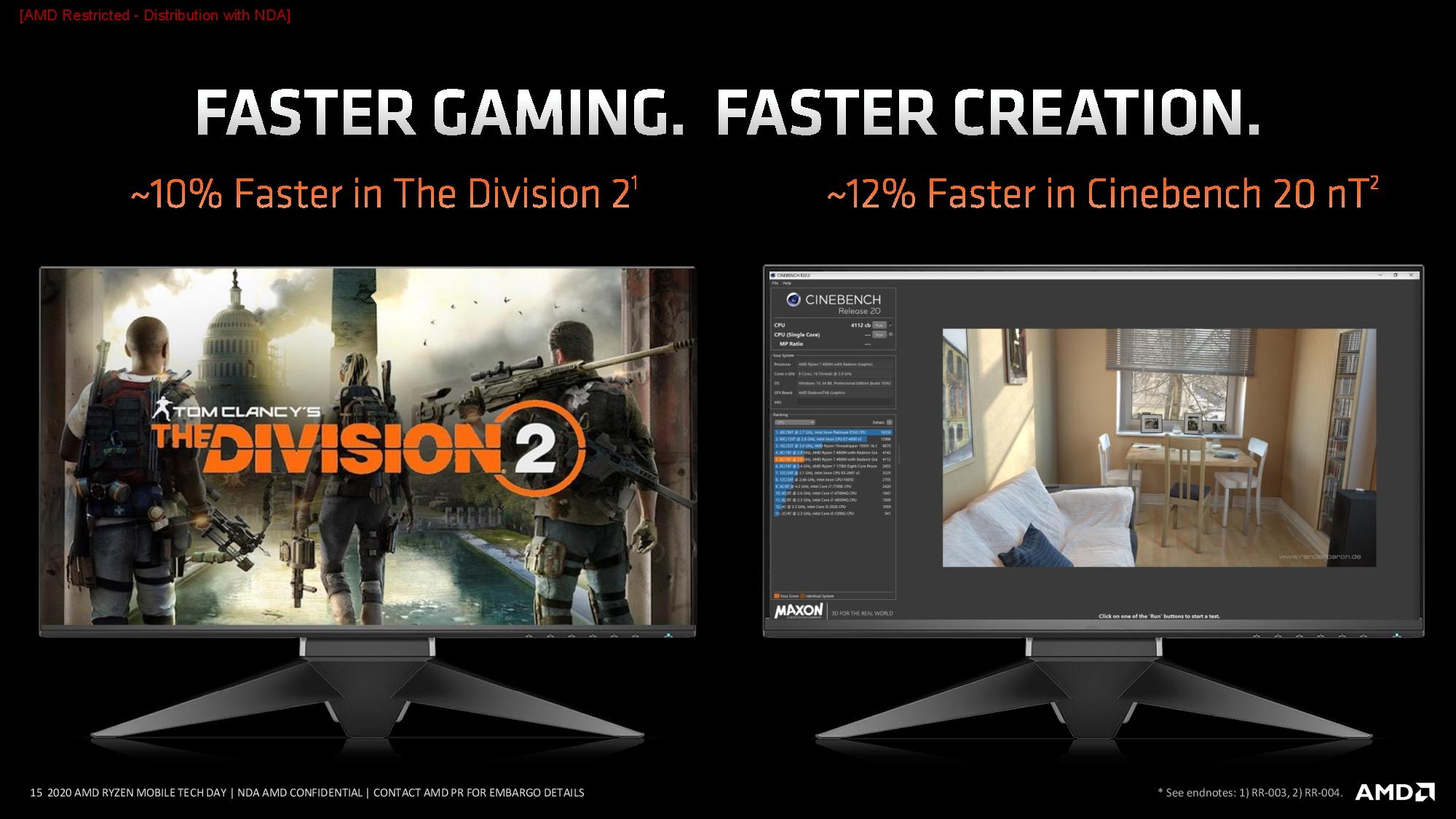
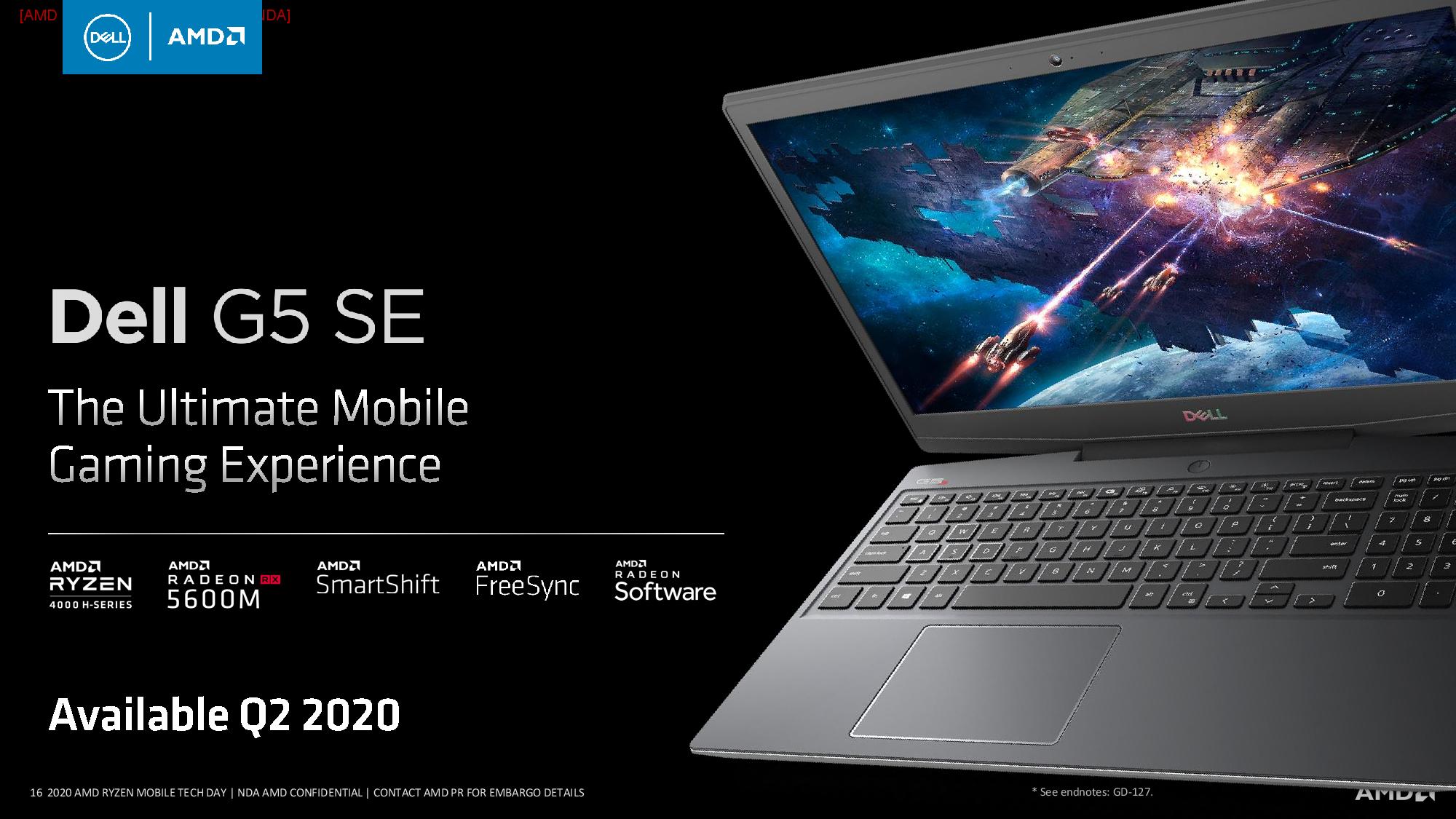
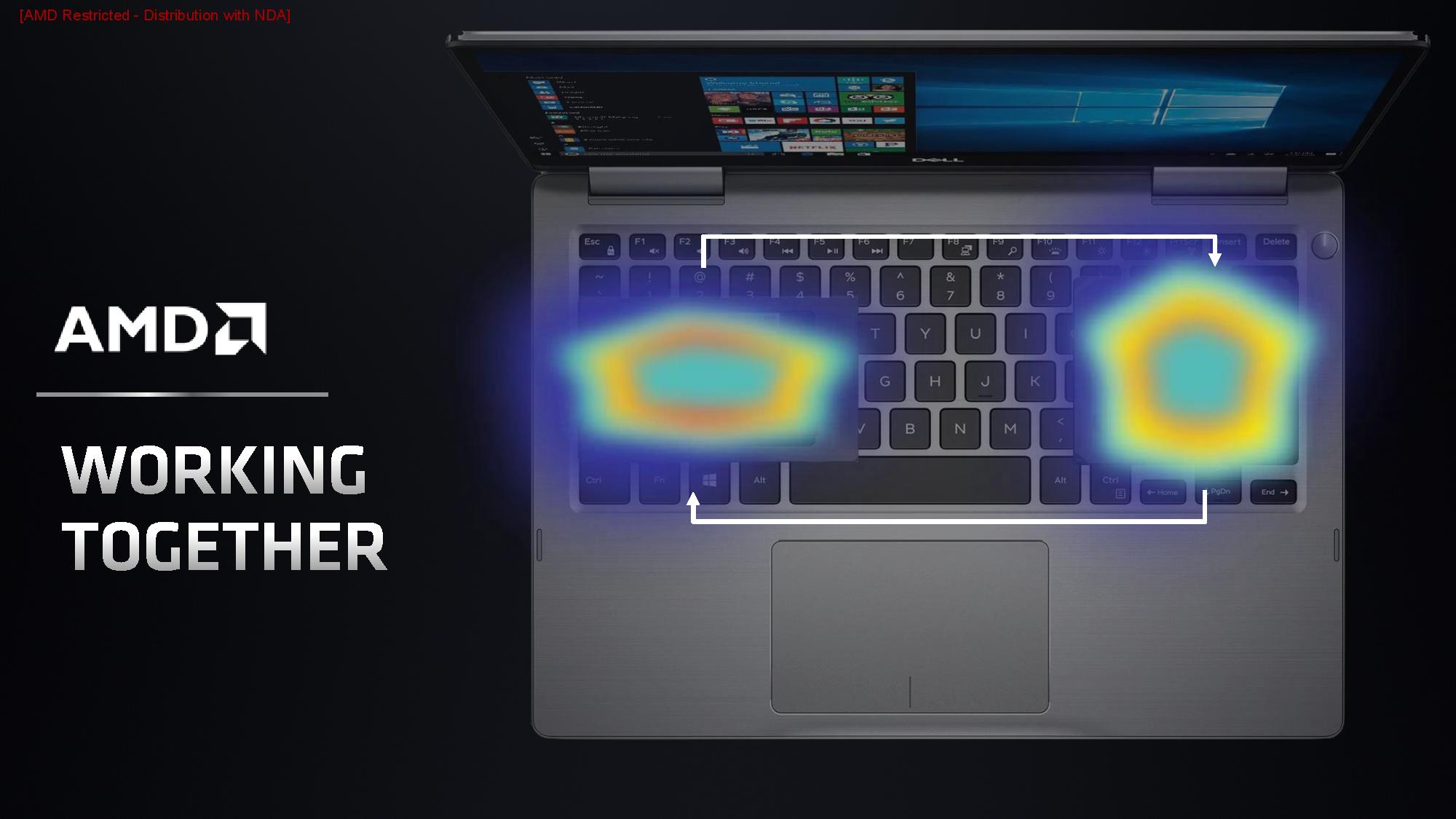
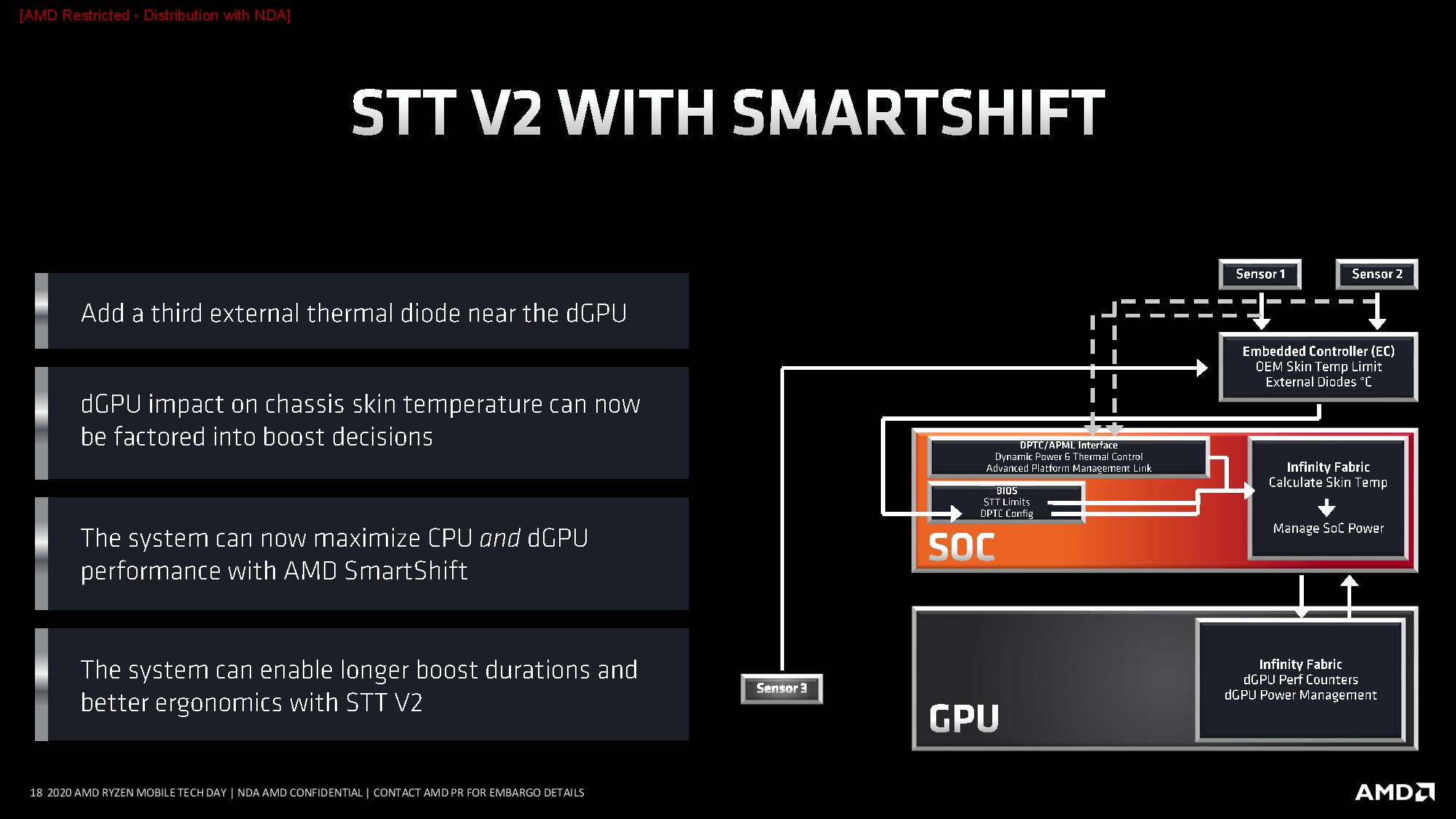
AMD also extended many of the same techniques it uses to control its APUs to the system level. The new SmartShift technology, the first of its kind, allows the system to dedicate more power to either the CPU or the GPU based upon its usage, thus boosting overall performance in a wide variety of workloads.
The system leverages AMD's advantage of being the only vendor (for now) with both CPUs and GPUs under one roof by making system-level power adjustments to optimize power and performance for the CPU and GPU. SmartShift-enabled systems must have both a Navi 10 (or greater) GPU and a Ryzen Mobile H-series CPU, although AMD may bring other combinations to market in the future.
Currently, many gaming notebooks come with powerful GPUs and CPUs that share the same unified cooling solution, such as a 45W GPU and 80W GPU housed under the same cooler. However, the cooler may only be able to dissipate 90W of heat in aggregate, which leads to constraints on either the CPU or GPU during heavy use.
AMD's SmartShift detects CPU and CPU utilization and temperature, then feeds that data into the Infinity Fabric resident on each component. That data is then shared across the PCIe bus to a platform control module that can adjust power allocation to the two devices, thus ensuring peak performance for either based upon workload. In many respects, this is akin to the Ryzen 4000 APU managing the discrete GPU as closely as it manages its own internal graphics engine.
For instance, during a CInebench render the GPU is largely idle, so allocating more of the power budget to the CPU can result in increased rendering performance (12% according to AMD's tests). Playing a game often results in the opposite condition: The CPU isn't being utilized fully while the GPU could benefit from extra power. AMD says that simply switching on SmartShift during The Division 2 results in up to 10% more performance.
This approach can work in tandem with AMD's skin temperature tracking technology to provide the optimal balance of power and performance where it's needed. In the end, this technology allows more performance in a smaller footprint and could enable OEMs to infuse higher-performance CPUs and GPUs into thinner devices. AMD says that Dell's G5 SE will be the first laptop to market with the feature, but Dell hasn't shared detailed performance specifications yet. The G5 SE comes to market in Q2 2020.
AMD 4000-Series APU Battery Life

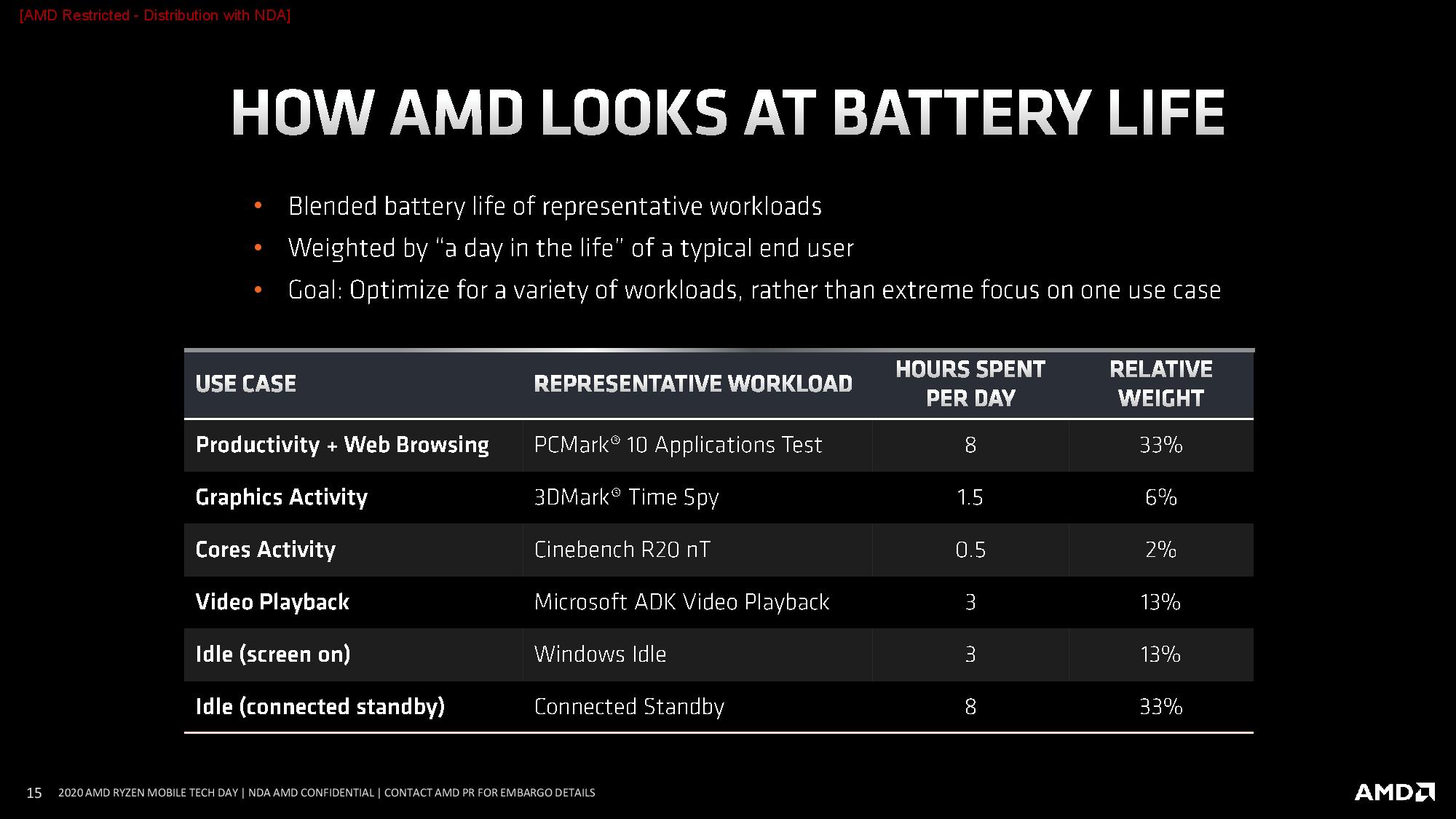
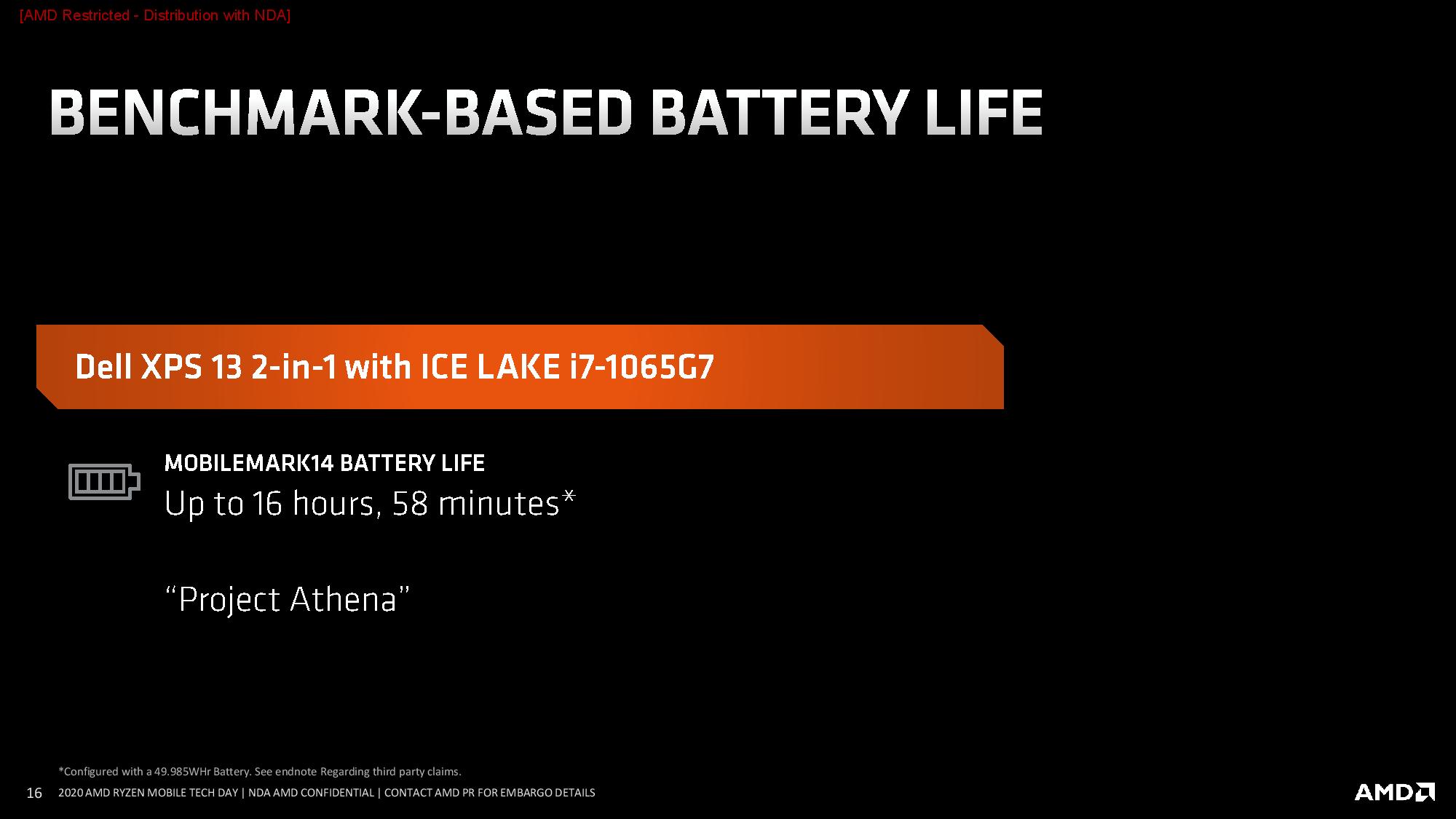
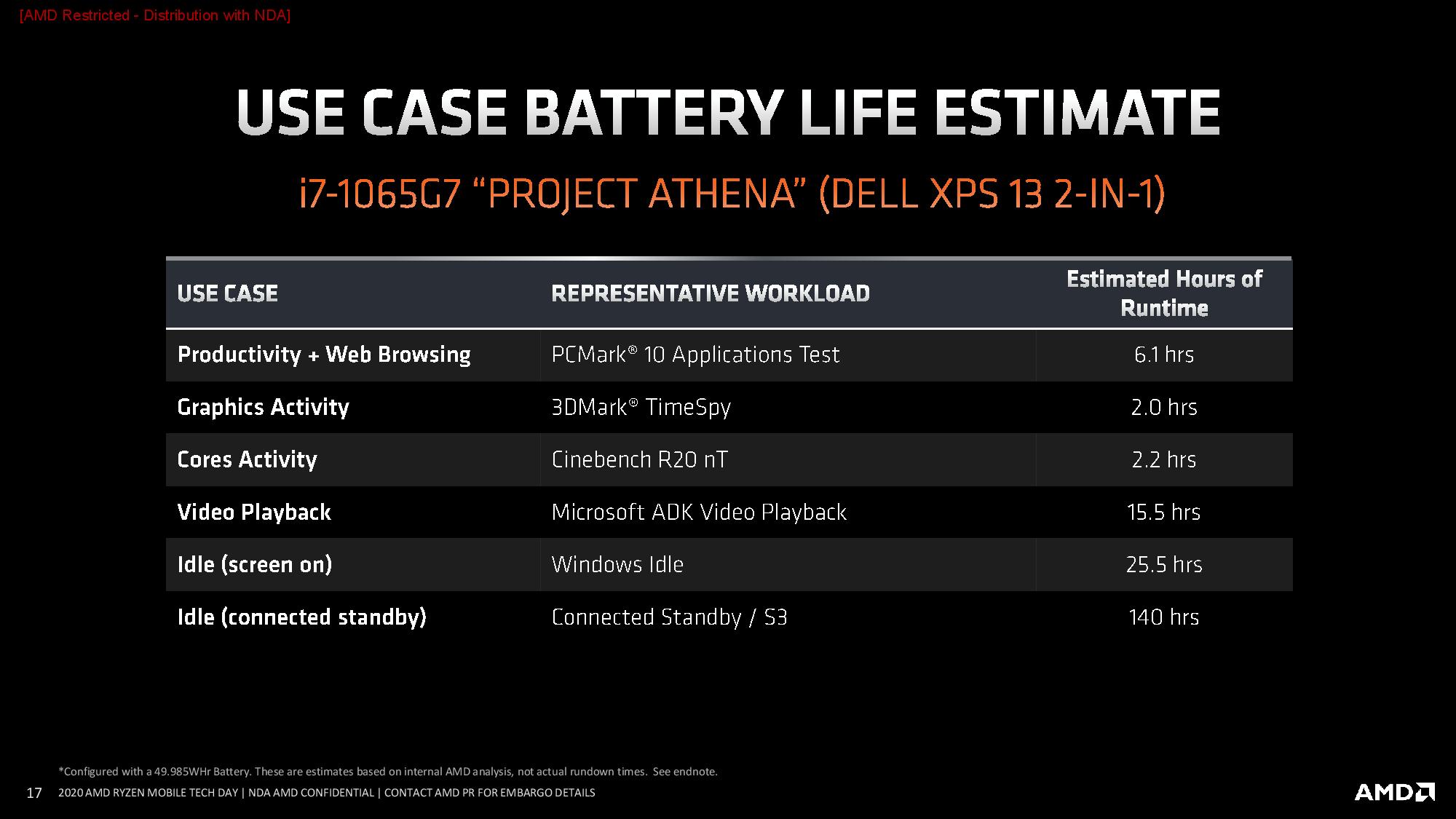
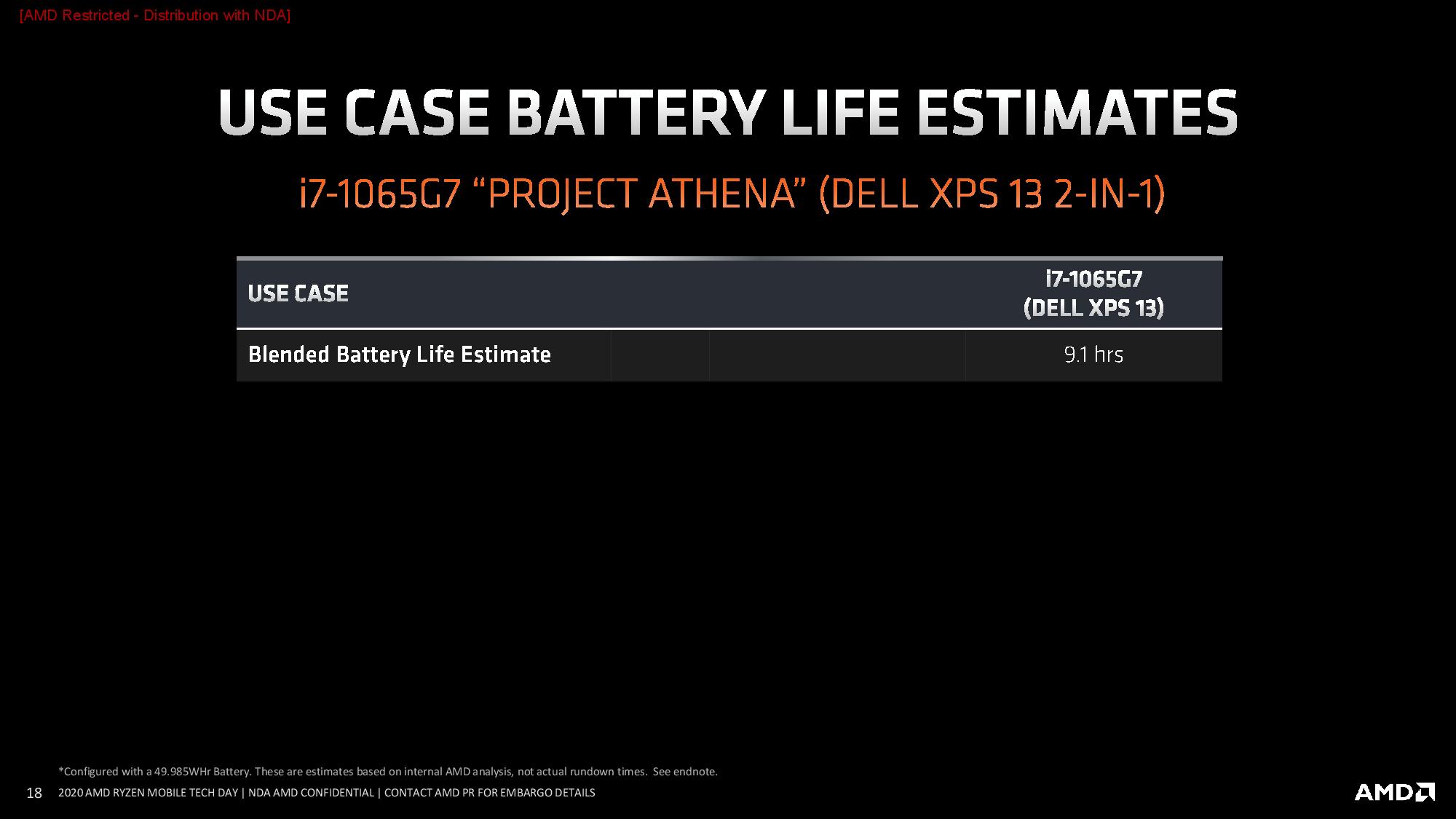
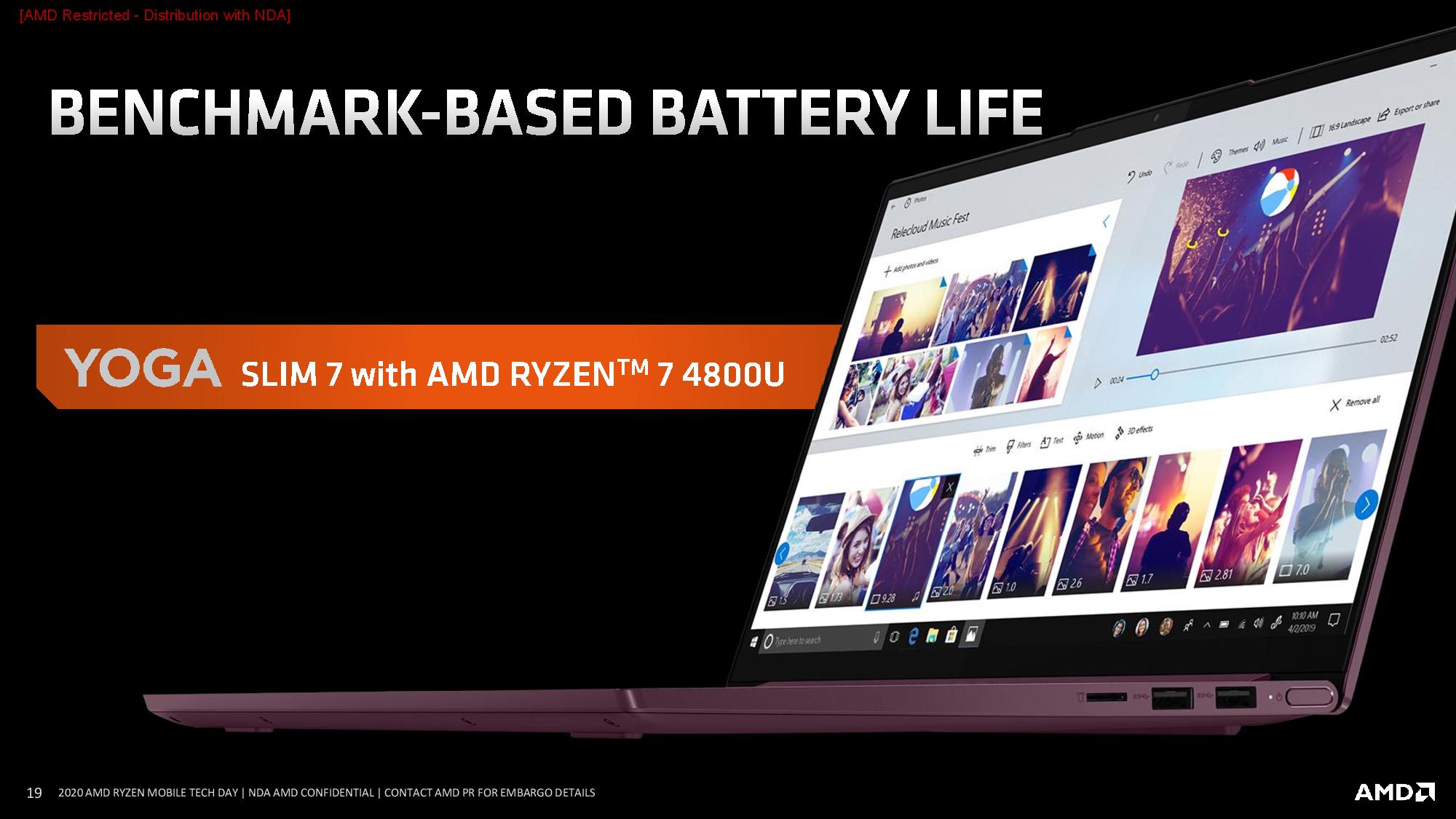
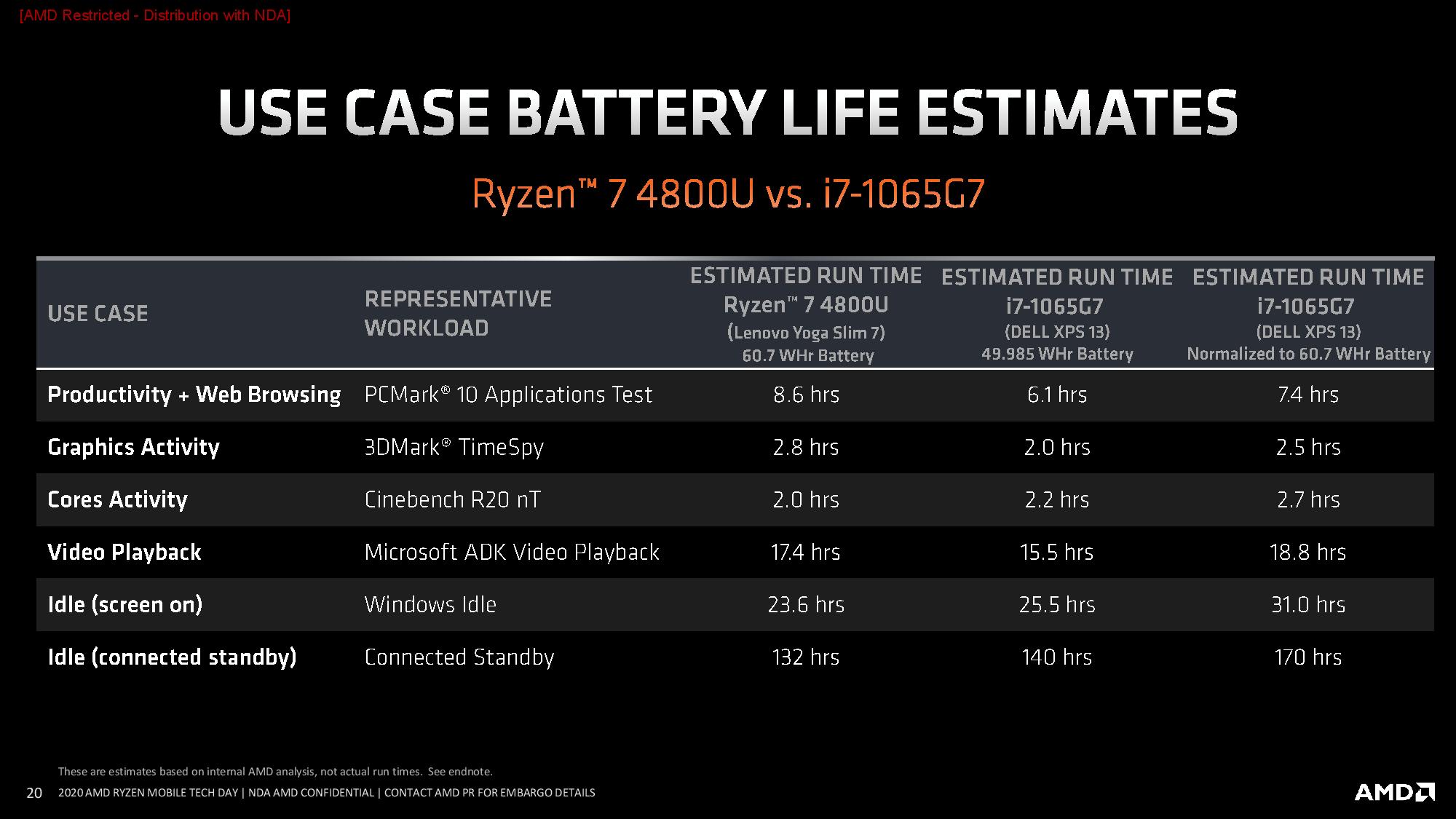
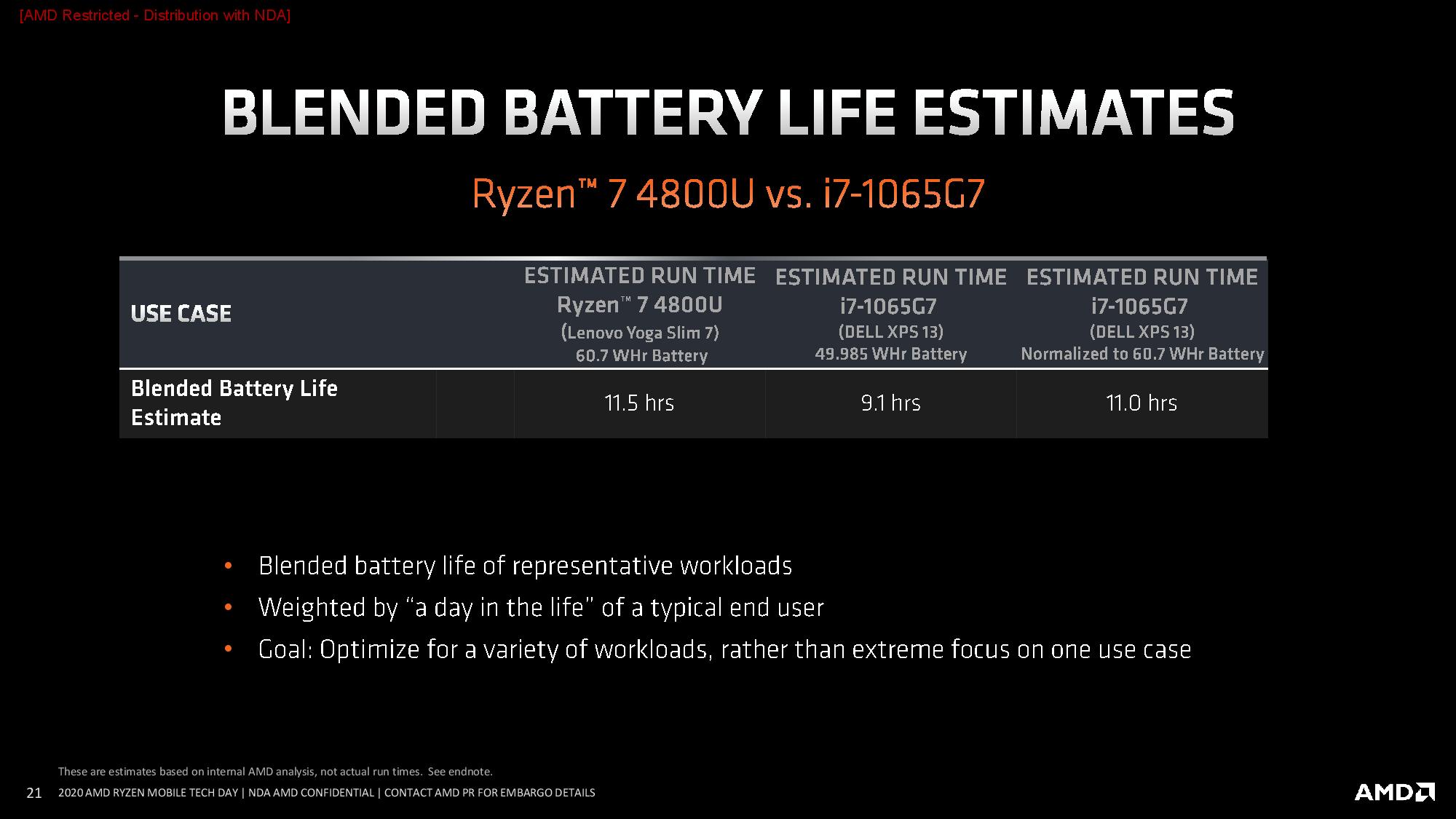
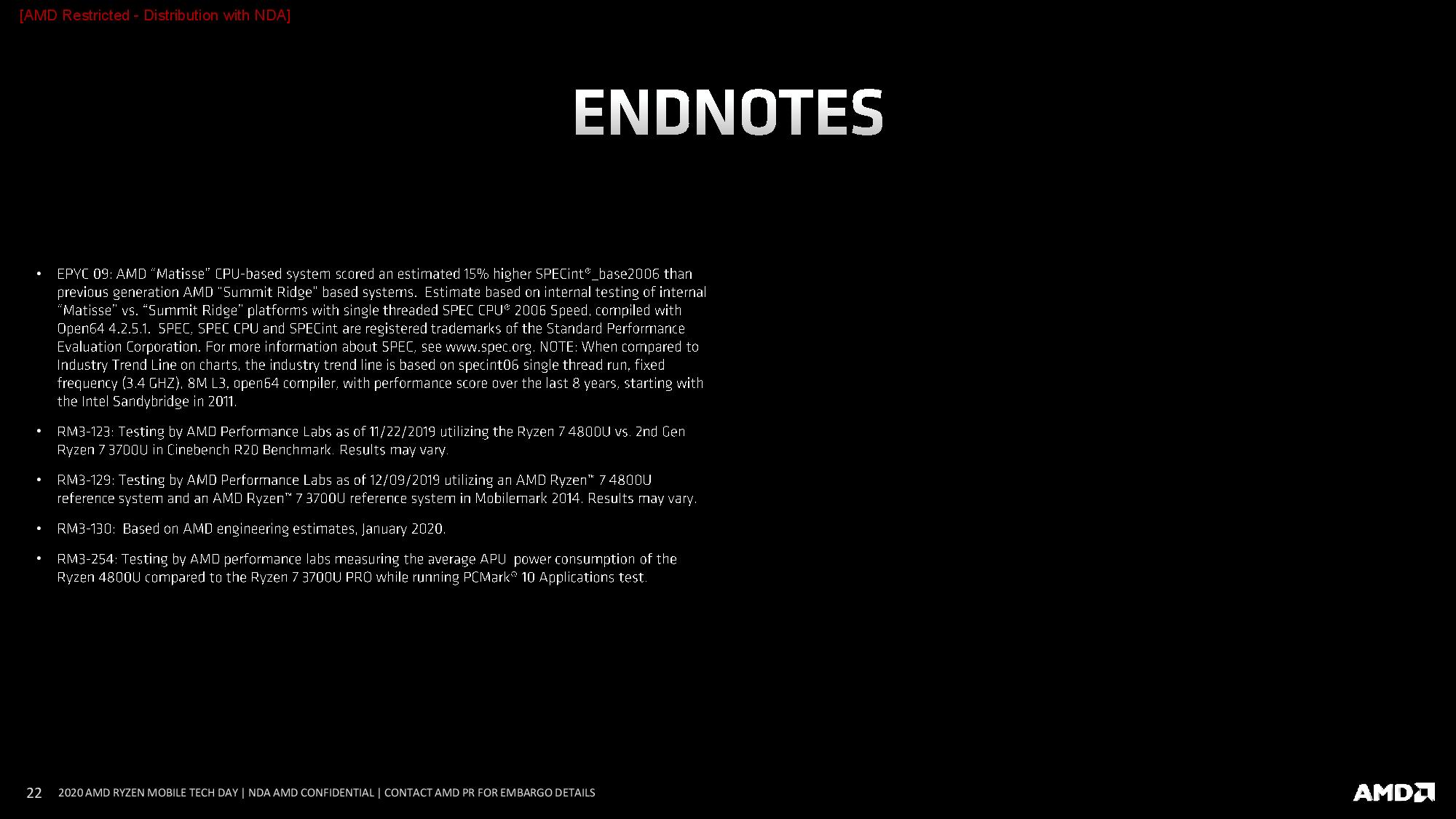
As with all laptop battery life claims, it's best to wait for reviews to see how performance pans out. In either case, AMD shared some data about its claims for Ryzen 4000 series battery usage. Battery usage varies based upon the type of work you're doing, and AMD contends that it offers a better balance of battery life across what it contends are the most important workloads. Take these projections with a grain of salt.
Tying it Together With AMD Radeon Software
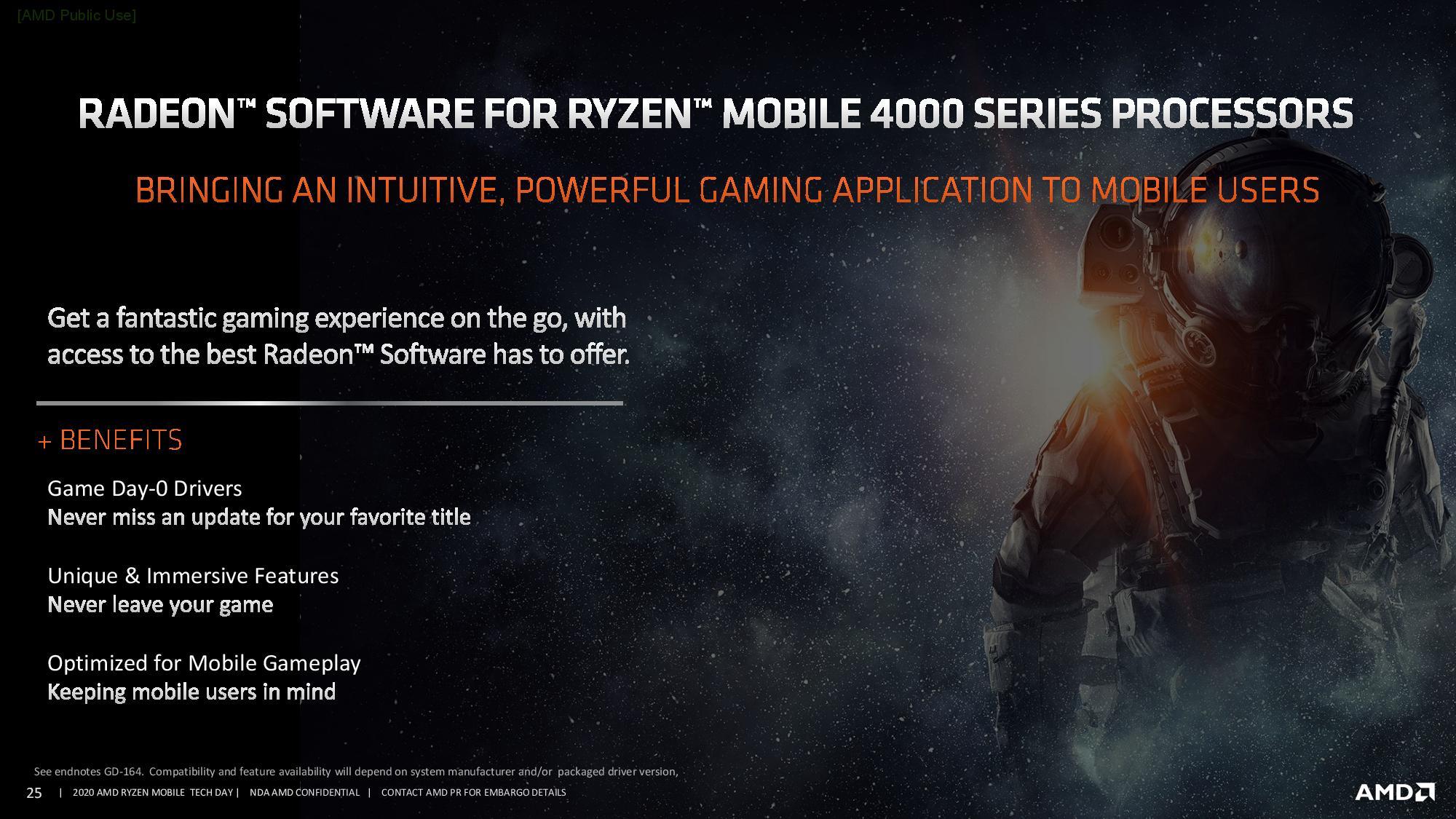
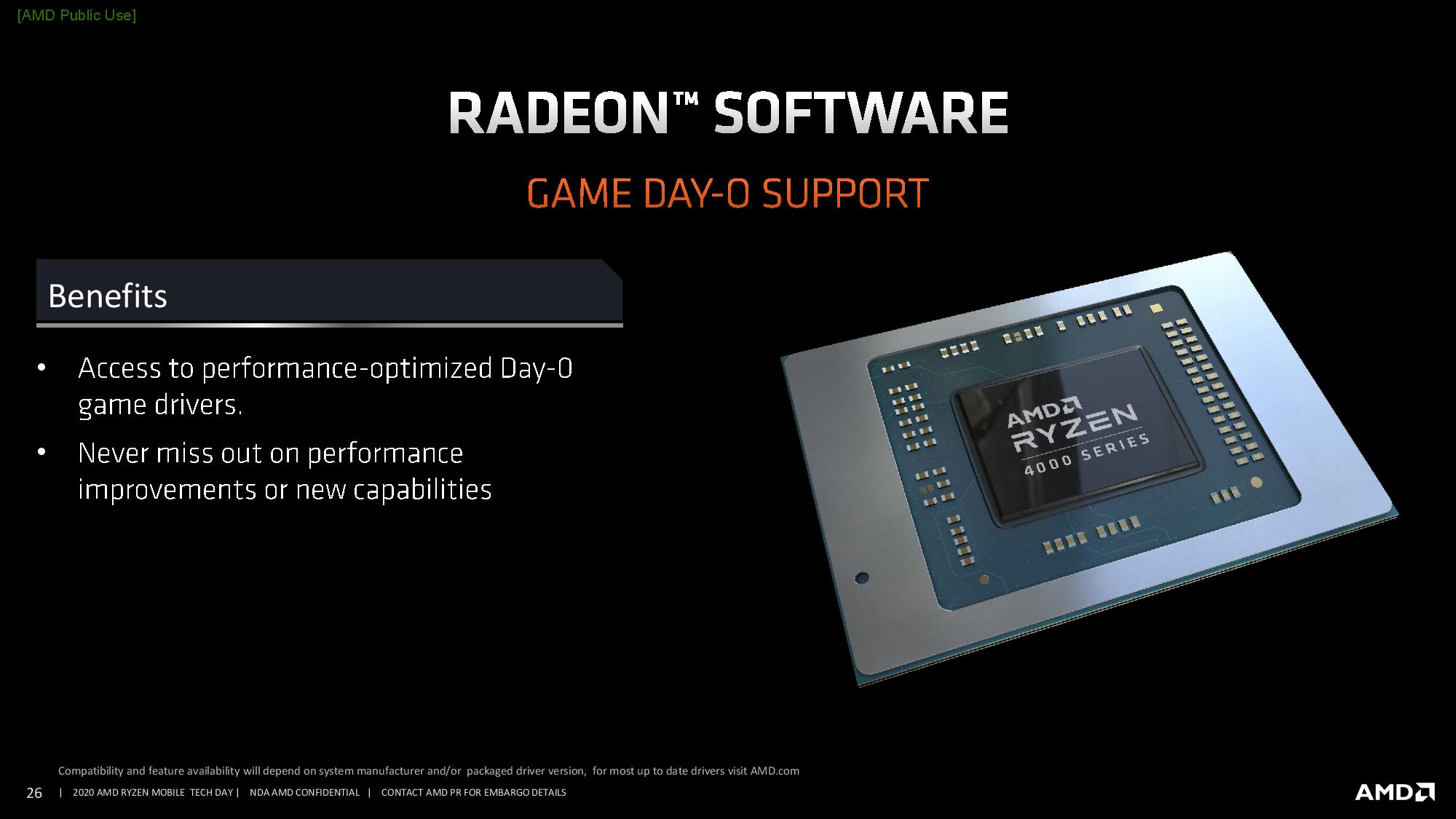
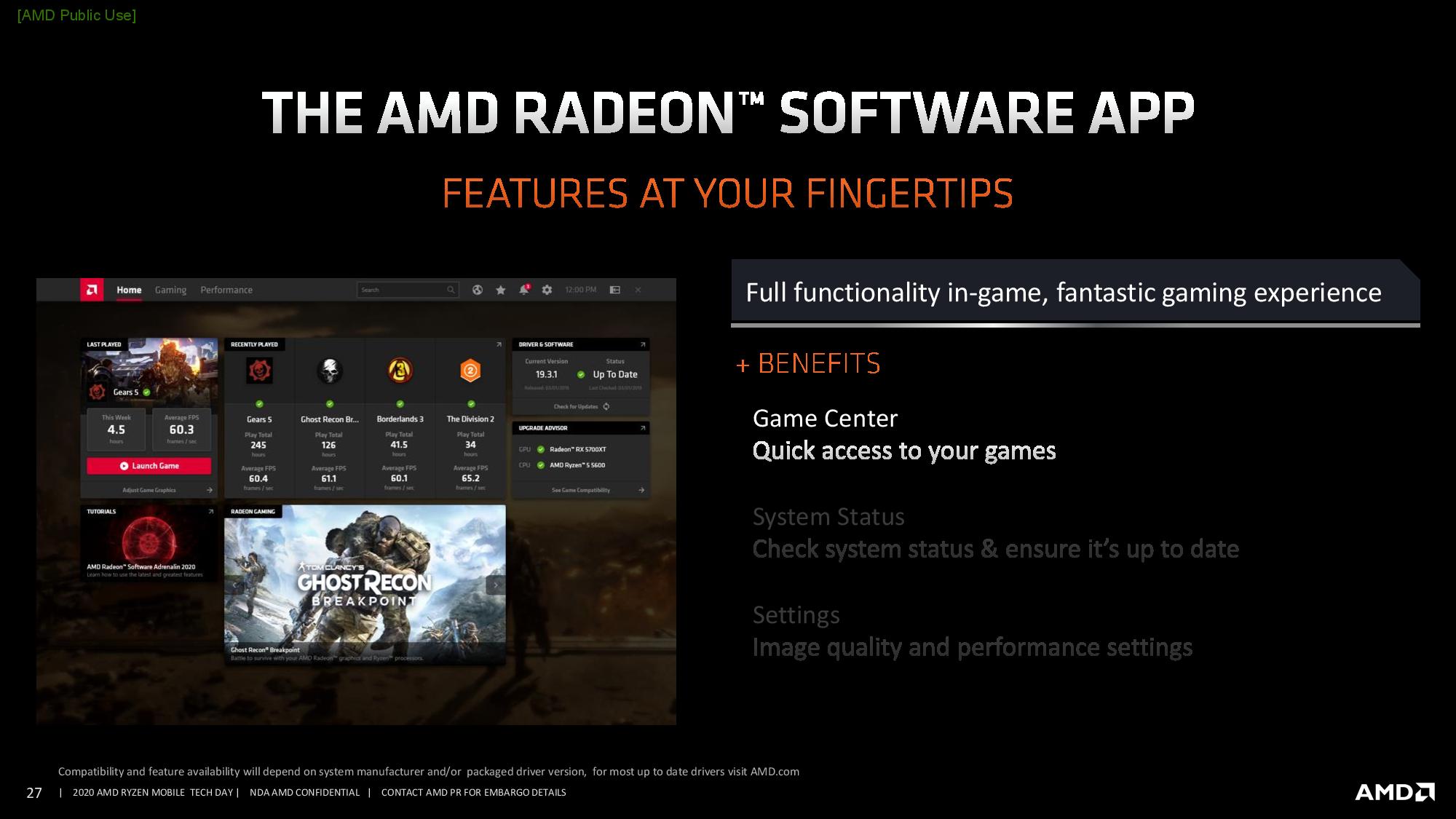

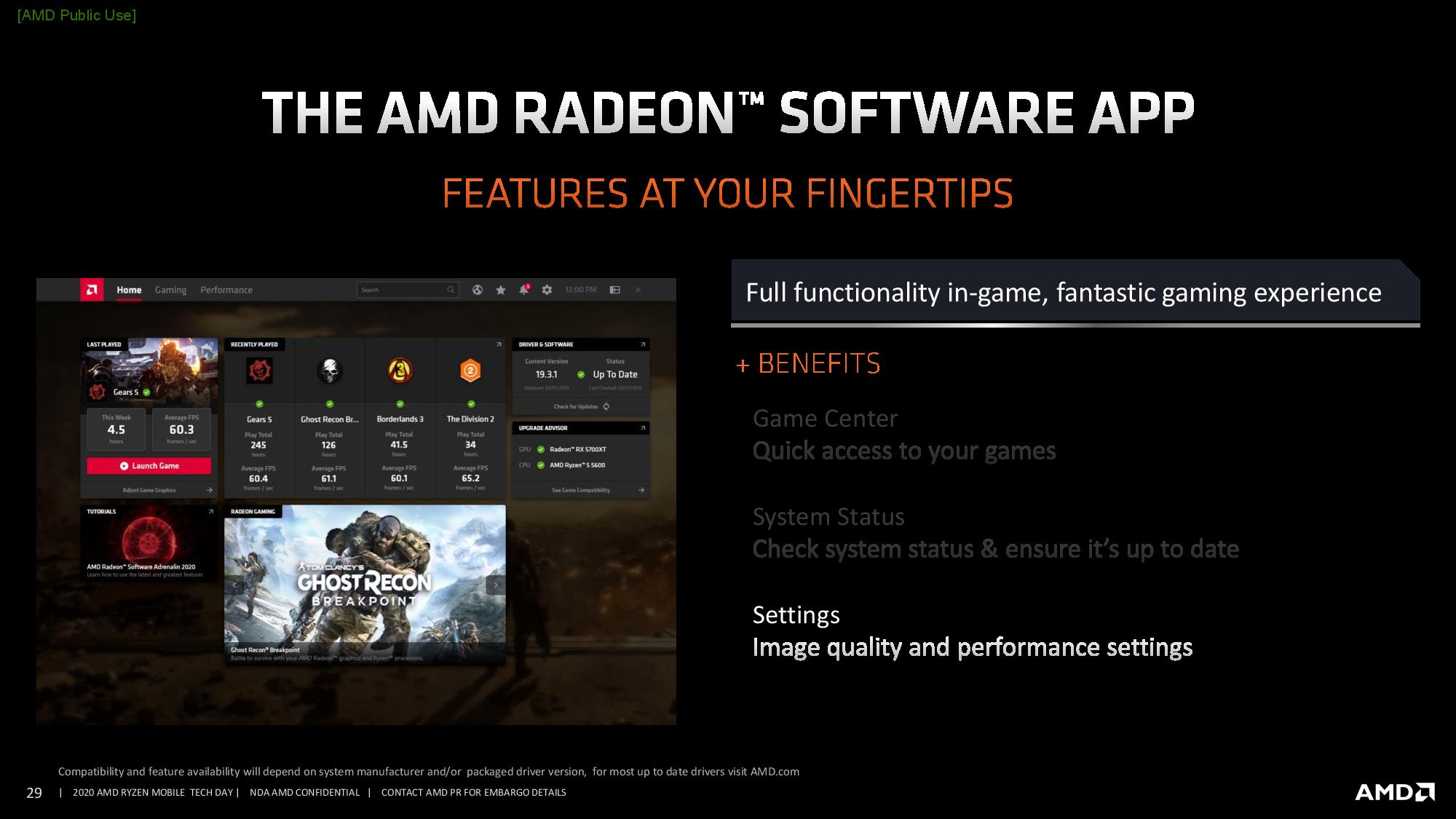
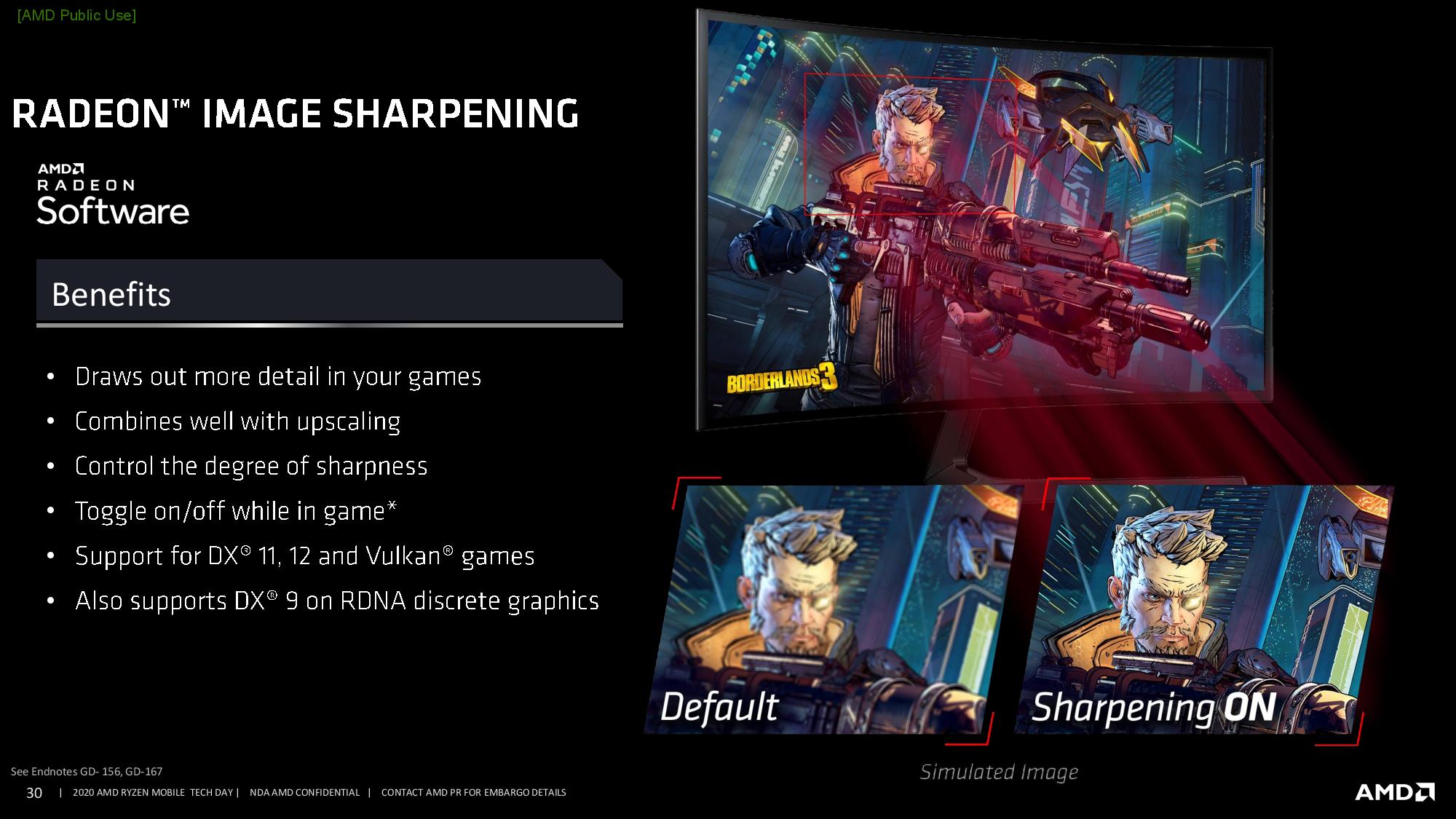
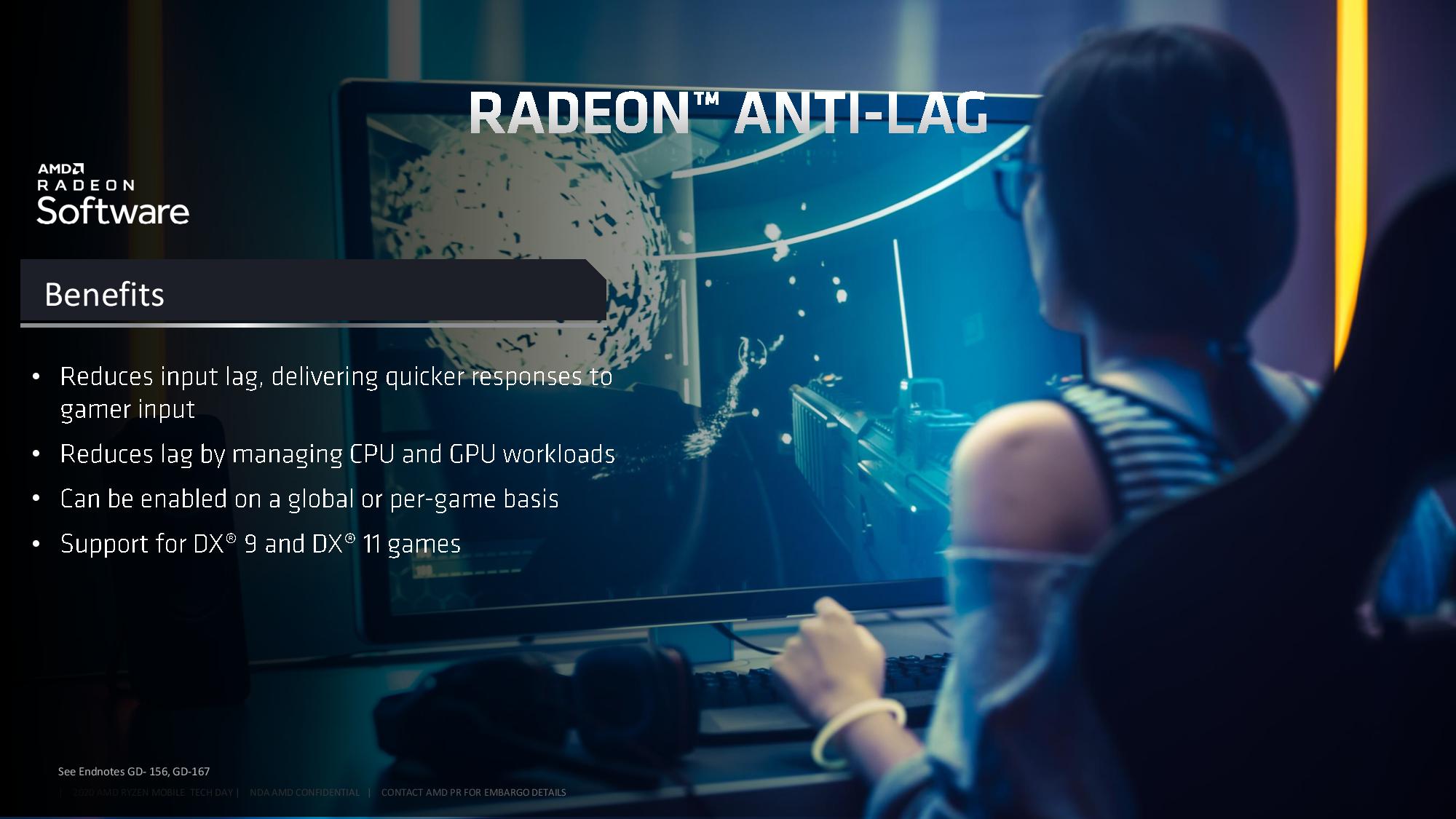
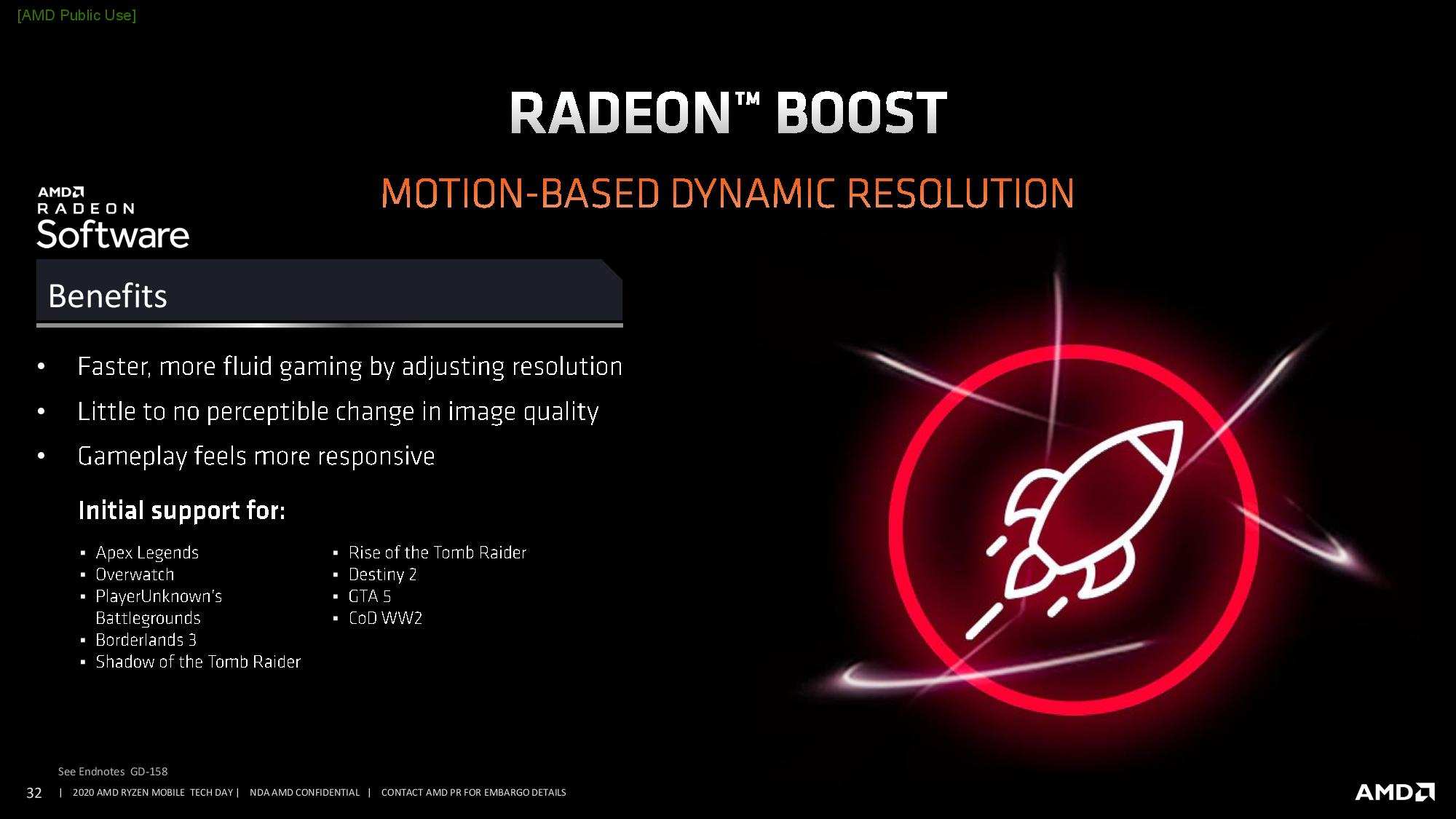
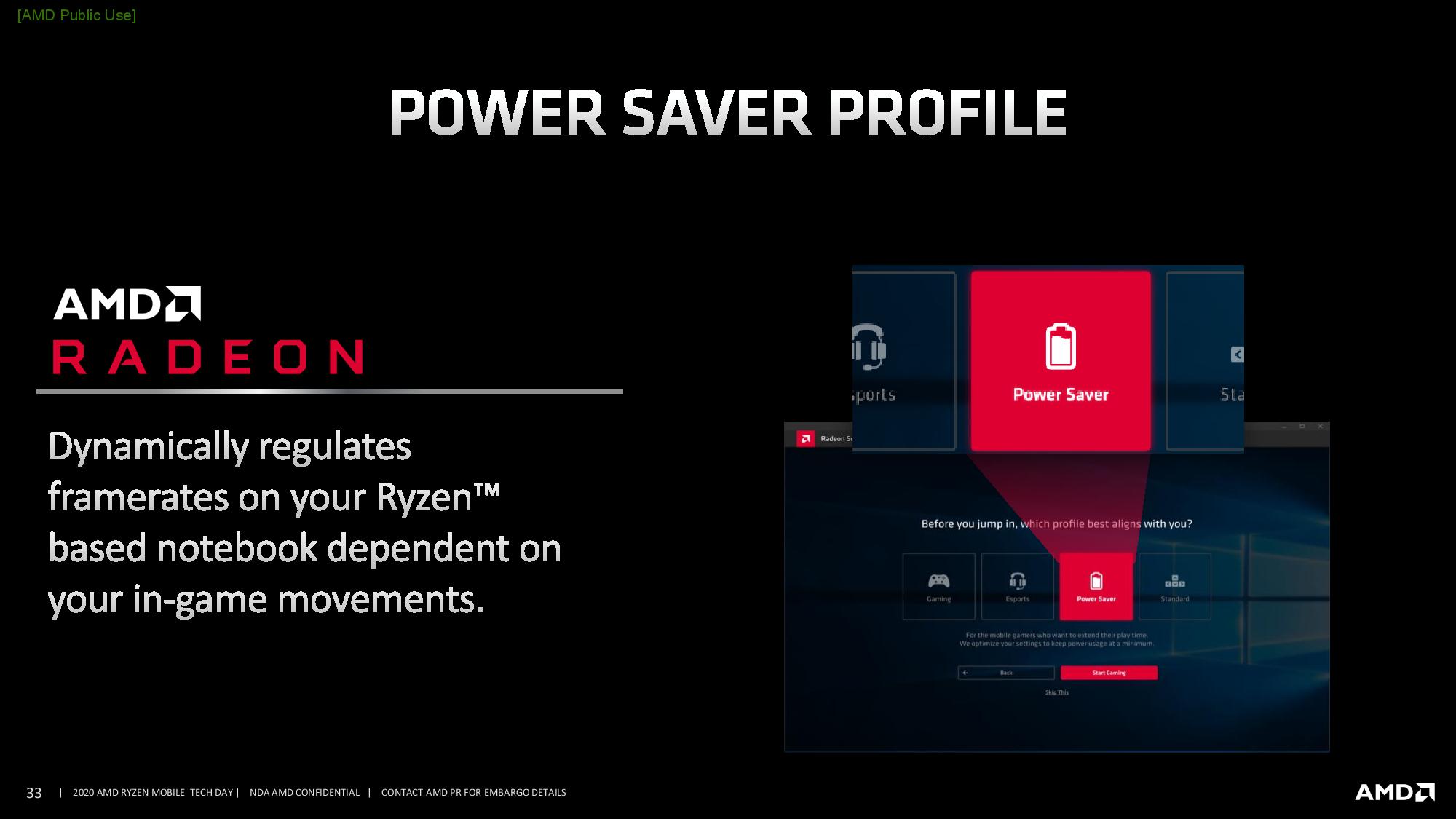
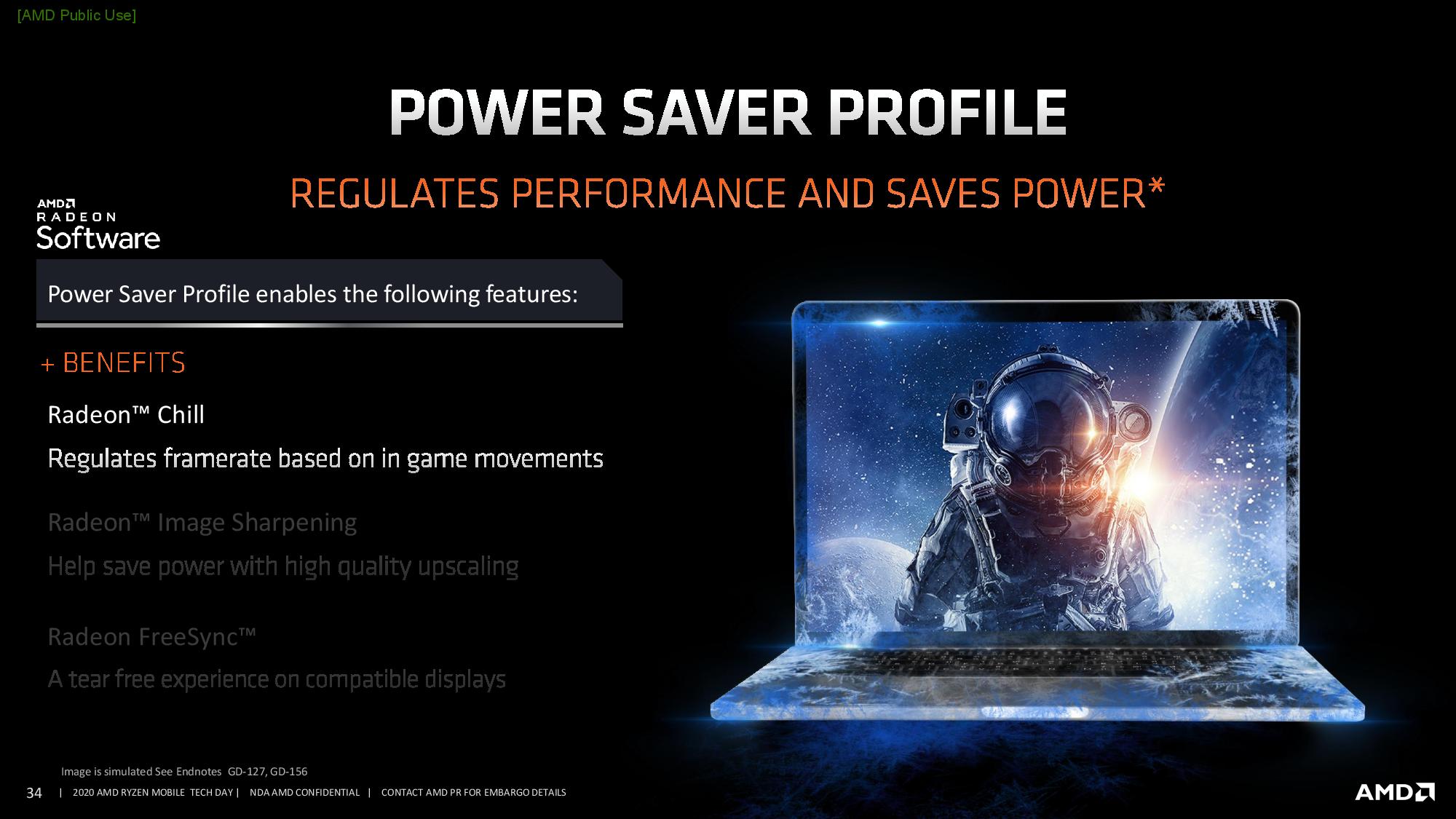

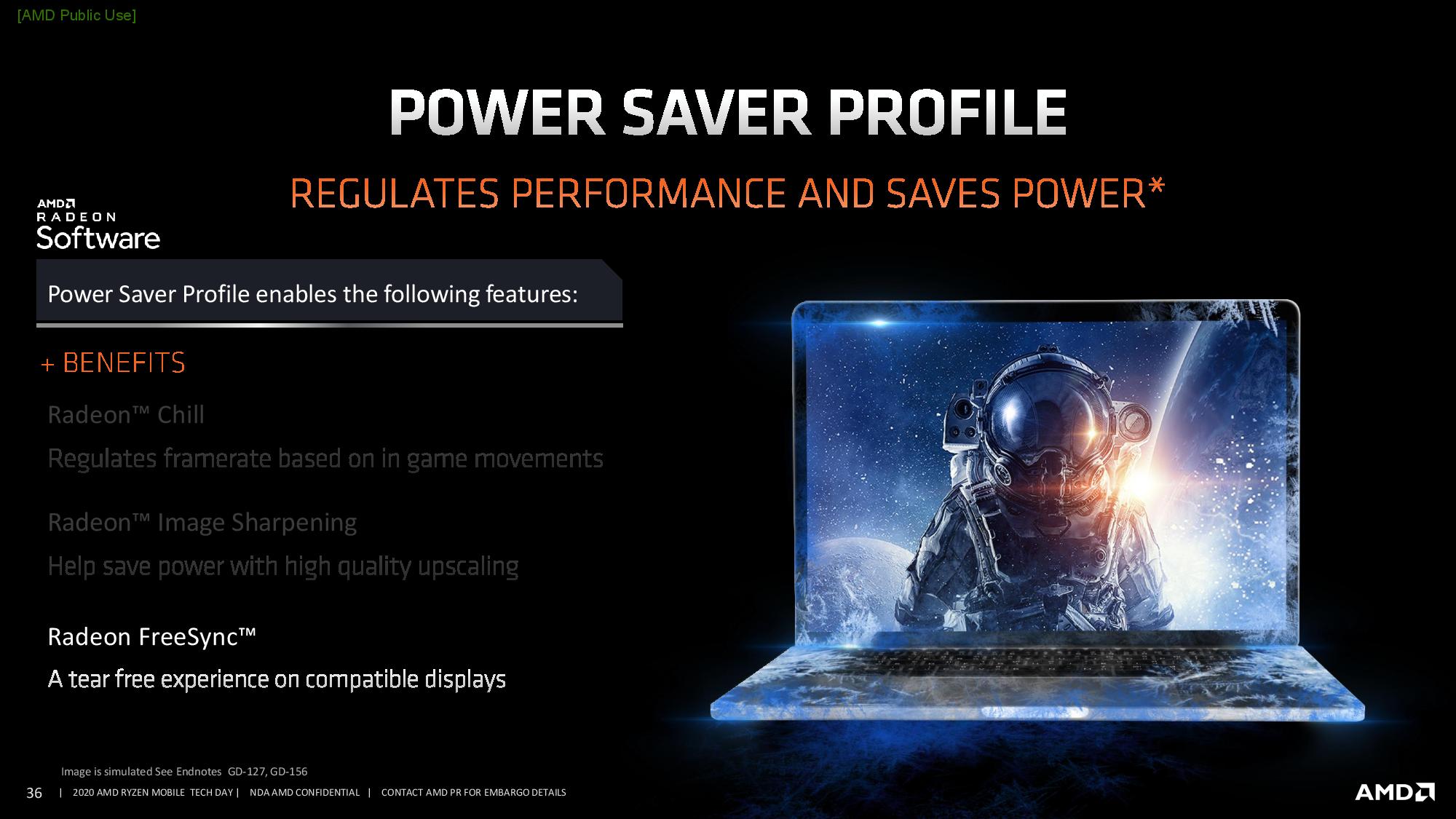
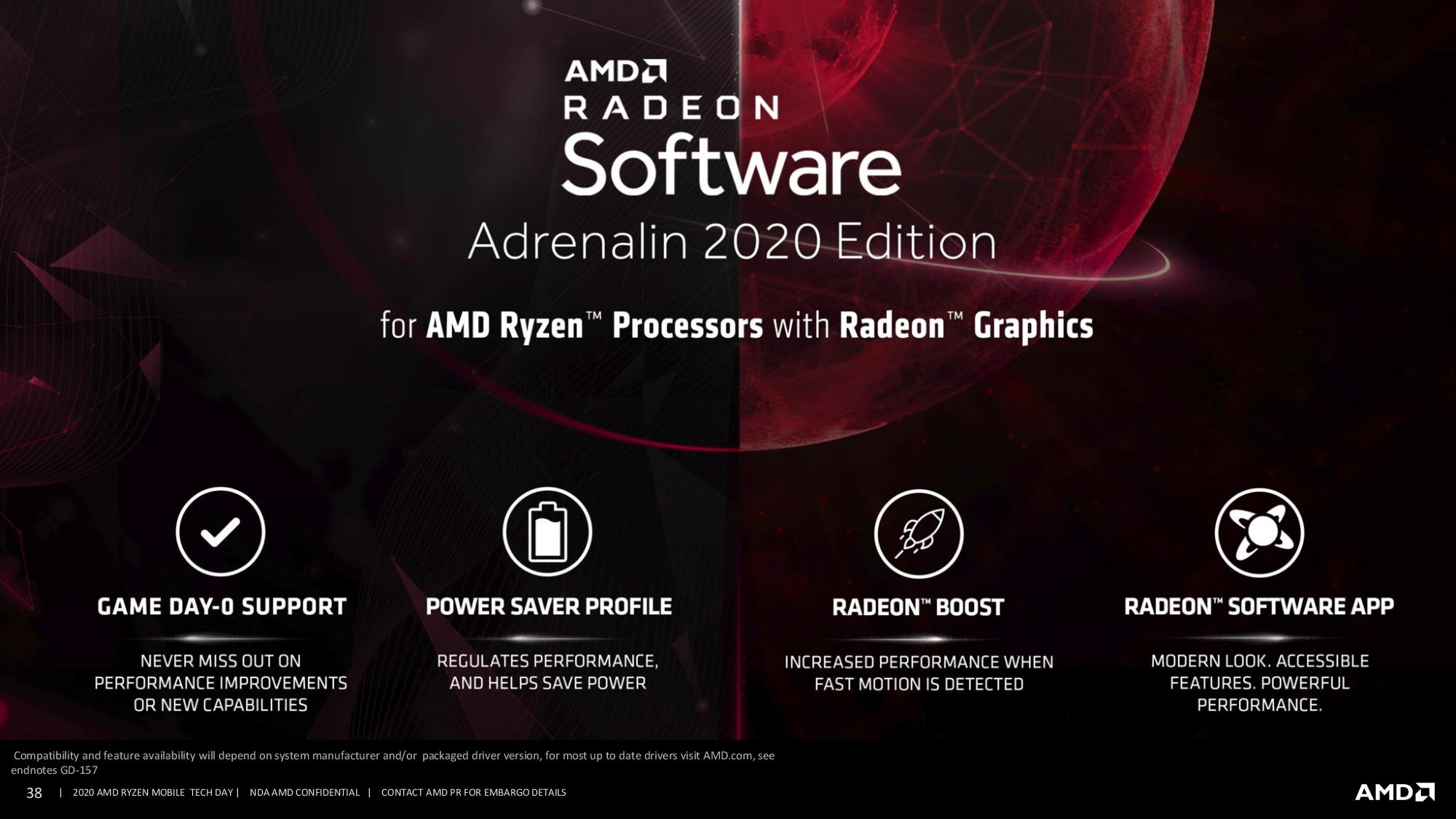
AMD has faced criticism in the past for its policy of allowing OEM vendors to dictate when graphics driver updates would come to market, often resulting in a lack of zero-day game drivers for laptops powered by its APUs. AMD discarded that practice and allowed all laptops with AMD's integrated graphics to use its broader software and driver suite, a practice it continues with the Ryzen 4000-series processors.
All of AMD's Ryzen Mobile 4000-series APUs can leverage the Adrenalin 2020 Edition and follow-on versions of its software, bringing many of its new features to bear for mobile users, like Radeon Image Sharpening, Anti-Lag technology, Radeon Boost, Radeon Chill, FreeSync, and the power saver profiles that are specifically designed for laptop usage.

Paul Alcorn is the Editor-in-Chief for Tom's Hardware US. He also writes news and reviews on CPUs, storage, and enterprise hardware.
-
Zizo007 Why can't we comment directly in articles anymore? Ads broke comments. Ads are so invasive here compared to Anandtech that they broke comments.Reply
4900H 4.4Ghz boost. That should beat any mobile Intel CPU including upcoming 10th gen. I wonder how strong the iGPU is? 1080p medium gaming? If it is, I might buy one for portable gaming and good battery life. I don't like laptop dGPU, I have one and it KILLS the battery. -
Umfriend I wonder the same thing (but for the 4900HS).Reply
What I do not understand is this: If the H-CPUs are to be coupled with dGPUs, then why include 8CUs? You would not need any, could well do with just 3?
I do not expect to see top-H-CPUs without dGPUs though, which is to bad. -
jeremyj_83 Reply
You still want the iGPU so that you can power down the dGPU when it isn't needed. Even running something as simple as Windows draws more power on the dGPU than iGPU. Less power draw means you can have a nice Gaming Laptop that can still have battery life.Umfriend said:I wonder the same thing (but for the 4900HS).
What I do not understand is this: If the H-CPUs are to be coupled with dGPUs, then why include 8CUs? You would not need any, could well do with just 3?
I do not expect to see top-H-CPUs without dGPUs though, which is to bad. -
Umfriend Reply
I understand that but, surely, simple tasks that do not require a dGPU can be done with fewer CUs? 8CUs should enable some medium gaming but once you game you'd want a dGPU probably. But what if, like me, you want raw CPU and IO but not graphics? The fewer CUs might allow for more cache for instance.jeremyj_83 said:You still want the iGPU so that you can power down the dGPU when it isn't needed. Even running something as simple as Windows draws more power on the dGPU than iGPU. Less power draw means you can have a nice Gaming Laptop that can still have battery life. -
jeremyj_83 Reply
Just like Intel, the highest end CPUs also get the best iGPUs as these are premium parts. The Ryzen 2200G iGPU is good enough for 900p gaming and the 2400G is good enough for some 1080p low settings, granted these are desktop parts with a 65W TDP. If the new mobile series iGPU with extra bandwidth might be able to push that to 1080p low across the board or do well for video decoding, etc... Yes typically you want a dGPU for high end gaming, but if you will only do it occasionally but need the added core for other work then it will be fine. Cache isn't an issue with the Ryzen as they already have more than the Intel CPUs.Umfriend said:I understand that but, surely, simple tasks that do not require a dGPU can be done with fewer CUs? 8CUs should enable some medium gaming but once you game you'd want a dGPU probably. But what if, like me, you want raw CPU and IO but not graphics? The fewer CUs might allow for more cache for instance. -
Umfriend Uhm, "more than Intel" != enough.Reply
So I get that 8CU might be enough for casual gaming but then I would not want it paired with a dGPU. What other work then gaming (or graphic content creation perhaps) needs more than, say, 2 CUs? -
jeremyj_83 Reply
Video editing it helped by extra CUs to a certain extent.Umfriend said:Uhm, "more than Intel" != enough.
So I get that 8CU might be enough for casual gaming but then I would not want it paired with a dGPU. What other work then gaming (or graphic content creation perhaps) needs more than, say, 2 CUs?
IO on a laptop is always limited. Even on huge chassis you might get 2x 2.5", 2x M.2 SSD, M.2 WiFi, ODD, and dGPU. That's it as the form factor doesn't allow for more. "All of the CPUs are PCIe 3.0 only, rather than PCIe 4.0 like the desktop parts. This is primarily due to power – the double bandwidth of PCIe 4.0 requires more power, and given that storage or graphics rarely need peak speeds, AMD felt the product portfolio would prefer battery life in this regard. Each chip has sixteen PCIe 3.0 lanes, split such that x8 is available for a graphics card, and two x4 links for storage. There are separate PCIe lanes for other modules such as Wi-Fi 6 or mobile network access (4G/5G). Display support for the CPUs allows for two 4K monitors through DisplayPort over Type-C, an additional 4K monitor if Thunderbolt is used, and a fourth monitor if USB 4.0 used. AMD has designed Renoir to not need additional chips to detect which way a Type-C is connected – that is all handled on die. With the display and USB support, the processor allows for concurrent USB 3.2 and DisplayPort use, with the peak DP v1.4 8.1G HBR3 standard in play using display stream compression (DSC)." There isn't much more on the IO that can be done after that.Umfriend said:But what if, like me, you want raw CPU and IO but not graphics?
In terms of CPU grunt, this is a Zen 2 CPU which has a ton of power as it is. Clock for clock it should be the same performance as its desktop cousins. If you need more power and IO than that, then you need to be on a desktop or HEDT platform. -
Bamda I am very excited about this. I have been wanting to upgrade my gaming laptop for a year. I am tired of the CPUs 4c/8t that intel just releases, having 8c/16t is exactly what I was looking for in a laptop. This is another great product release. Thank you, AMD!Reply